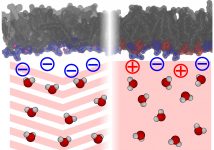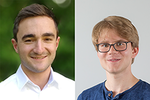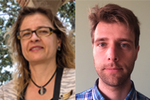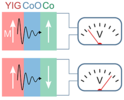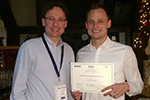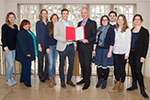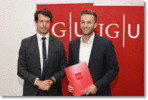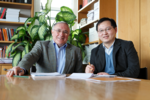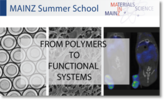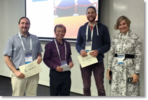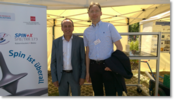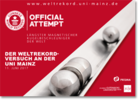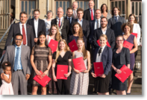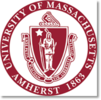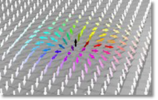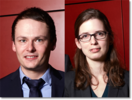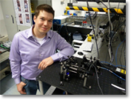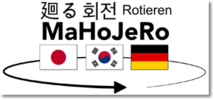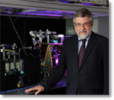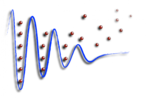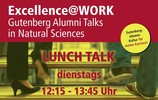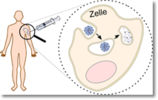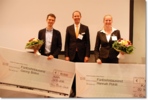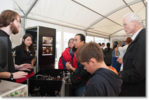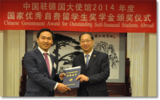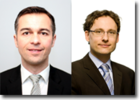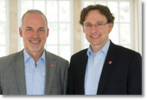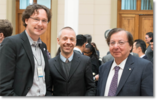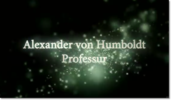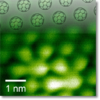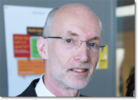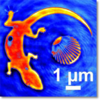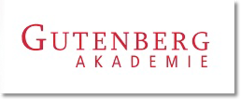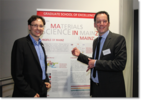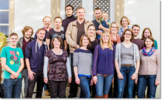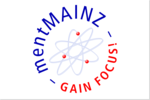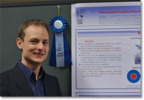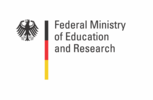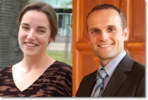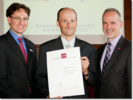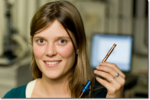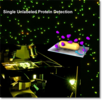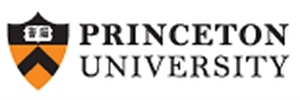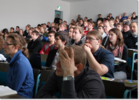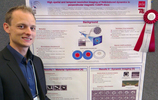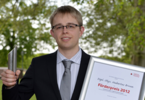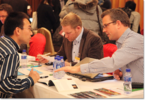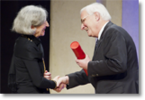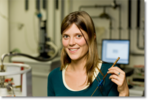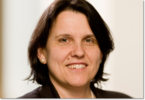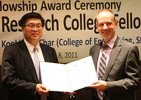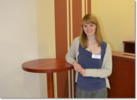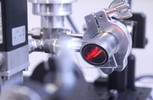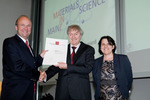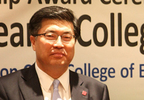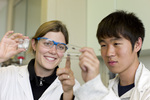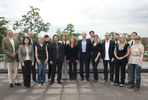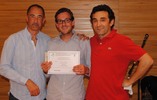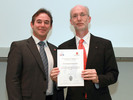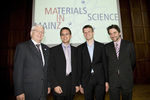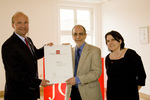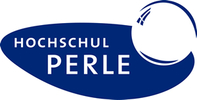MAINZ Award 2018 goes to Fabian Letscher, Kai Litzius and Alexey Sapozhnik
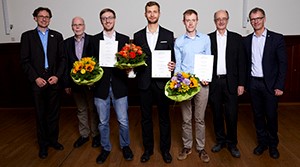 The Graduate School of Excellence Materials Science in Mainz (MAINZ) at Johannes Gutenberg University Mainz (JGU) has awarded Fabian Letscher, Kai Litzius and Alexey Sapozhnik for the MAINZ Award 2018.
The Graduate School of Excellence Materials Science in Mainz (MAINZ) at Johannes Gutenberg University Mainz (JGU) has awarded Fabian Letscher, Kai Litzius and Alexey Sapozhnik for the MAINZ Award 2018.
Fabian Letscher receives the MAINZ Award 2018 for his work on “Nonequilibrium dynamics of driven dissipative Rydberg gases”. Fabian studied Physics at TU Kaiserslautern, finishing with a Diploma thesis in the group of Michael Fleischhauer in 2014. He continued his research work in the same group for his PhD, which included collaborations with groups in Kaiserslautern, the University of Chicago, and the Foundation for Research and Technology - Hellas. Beyond his own research work, Fabian was active as a co-organizer of the Physics Day at TU Kaiserslautern in 2017. Fabian now works at Carl Zeiss SMT GmbH.
Kai Litzius is awarded with the MAINZ Award 2018 for his thesis on “Spin-Orbit-Induced Dynamics of Chiral Magnetic Structures“. After finishing his BSc in Physics at JGU in 2013, Kai joined MAINZ as a fast-track PhD student. He performed his research in the group of Mathias Kläui in collaboration with the MPI for Intelligent Systems and received a fellowship by the German Academic Scholarship Foundation. Kai is a member of the editorial board of the Journal of Unsolved Questions (JUnQ). An extended research stay during his PhD led him to the MIT where he worked with Geoffrey Beach whom he has again joined for a Postdoc.
Alexey Sapozhnik is awarded with the MAINZ Award 2018 for his thesis on “Magnetic Properties of Antiferromagnetic Mn2Au: Exchange Interaction and Domain Manipulation“. After studying Physics at Novosibirsk National Research State University, Alexey joined MAINZ under the co-supervision of Hans-Joachim Elmers and MAINZ Visiting Professor Hartmut Zabel. He was co-organizer of the MAINZ Summer Schools “New Directions in Spintronics Research” in Shanghai and Beijing in 2016 and 2017, respectively. Following his PhD, Alexey moved to EPFL for a Postdoc.
photo (fltr): MAINZ Director Prof. Dr. Mathias Kläui, MAINZ Visiting Professor Prof. Dr. Hartmut Zabel, MAINZ Awardee Dr. Kai Litzius, MAINZ Awardeee Dr. Alexey Sapozhnik, MAINZ Awardee Dr. Fabian Letscher, MAINZ PI Hans-Joachim Elmers, MAINZ PI Michael Fleischhauer. photo/©: Frank Wiedemeier/MAINZ
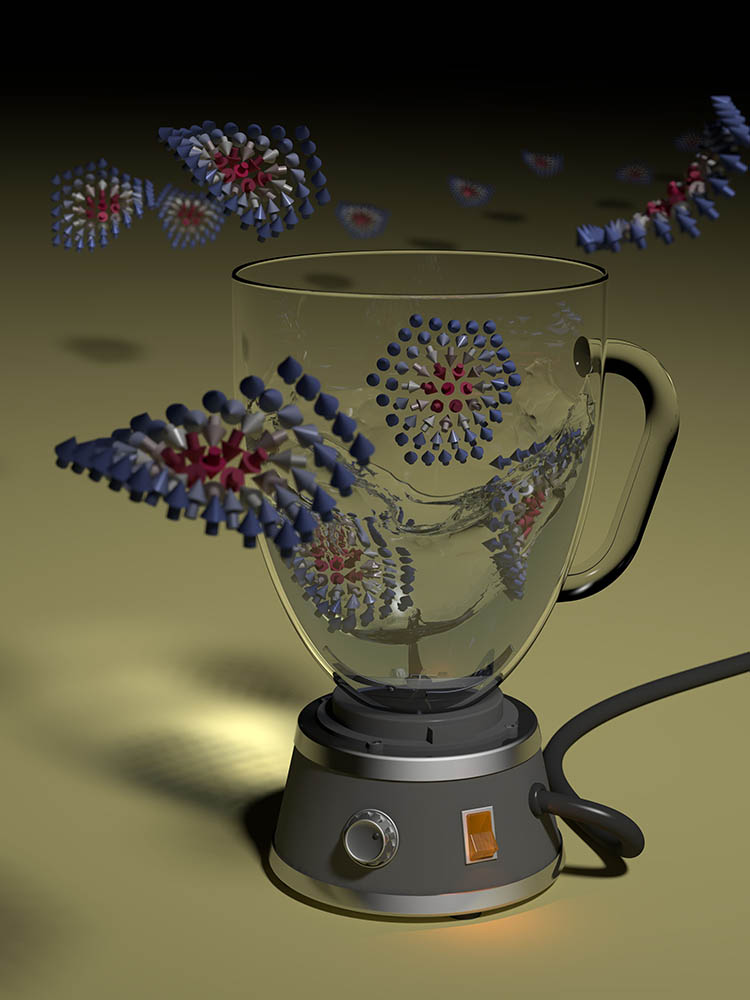
Researchers at Johannes Gutenberg University Mainz (JGU) have succeeded in developing a key constituent of a novel unconventional computing concept. This constituent employs the same magnetic structures that are being researched in connection with storing electronic data on shift registers known as racetracks. In this, researchers investigate so-called skyrmions, which are magnetic vortex-like structures, as potential bit units for data storage. However, the recently announced new approach has a particular relevance to probabilistic computing. This is an alternative concept for electronic data processing where information is transferred in the form of probabilities rather than in the conventional binary form of 1 and 0. The number 2/3, for instance, could be expressed as a long sequence of 1 and 0 digits, with 2/3 being ones and 1/3 being zeros. The key element lacking in this approach was a functioning bit reshuffler, a device that randomly rearranges a sequence of digits without changing the total number of 1s and 0s in the sequence. That is exactly what the skyrmions are intended to achieve. The results of this research have been published in the journal Nature Nanotechnology.
Further information can be found at: http://www.uni-mainz.de/presse/aktuell/8323_ENG_HTML.php.
25.04.2019
Driving chemical reactions with light: New publication by Benjamin Förster et al.
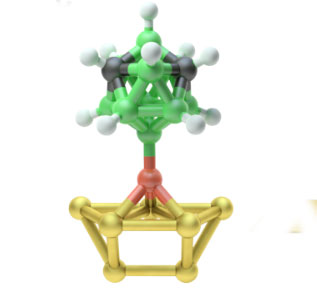
How can chemical reactions be triggered by light, following the example of photosynthesis in nature? This process is still poorly understood. However, researchers from Johannes Gutenberg University Mainz (JGU) in Germany und Rice University in Houston, USA, have now uncovered a major piece of the puzzle. Their findings have been published recently in Science Advances.
Further information can be found at: http://www.uni-mainz.de/presse/aktuell/8359_ENG_HTML.php.
23.01.2019
Collision of individual atoms leads to twofold change of angular momentum
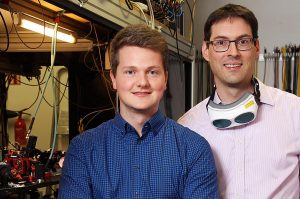
Thanks to new technology, it is possible to retain individual atoms, move them in a targeted manner or change their condition. Kaiserslautern physicists also work with this system. In a recent study, they investigated the consequences of the collision of two atoms in a weak magnetic field at low temperature. For the first time they have discovered that atoms, carrying their angular momentum in individual packets (quanta), thereby exchange two packets. It was also shown that the interaction strength between the atoms can be controlled. This is of interest for investigating chemical reactions, for example. The paper was published in the journal Physical Review Letters.
Until a few decades ago it was unthinkable for physicists to carry out experiments with individual atomic particles. Erwin Schrödinger, one of the pioneers of modern quantum theory, expected “ridiculous consequences” from this idea and described it as similarly probable to raising an Ichtyosaurus dinosaur in a zoo. However, advances in laser technology and atomic physics today make experiments with individual atoms possible.
Physicists around Professor Artur Widera and his doctoral student Felix Schmidt at Technische Universität Kaiserslautern (TUK) are also working on this topic in the Individual Quantum Systems research group. They rely on a so-called Bose-Einstein condensate consisting of rubidium atoms. “In physics, this refers to a state of matter that is comparable with liquid and gaseous states. However, such a condensate is a perfect quantum mechanical state that behaves like a wave,” says Professor Widera. The condensate is comparable to a gas consisting of very few atoms.
In a recent study, together with Professor Eberhard Tiemann of the Gottfried Wilhelm Leibniz University of Hanover, they investigated the effects of a single caesium atom hitting a rubidium atom. To observe the particles, the researchers must first cool them to temperatures just above absolute zero. “We then used optical tweezers to bring the atoms into contact with each other,” says Felix Schmidt. During this process, atoms are retained using laser beams. The researchers have now added a single caesium atom to the rubidium gas to measure what happens before and after the collision of the atoms.
The physicists observed how the particles change their angular momentum during the impact by measuring the state of the individual caesium atom before and after the collision. In atoms, the angular momentum of the particles is to a certain extent present in individual packages – so-called elementary quanta. The researchers have now observed that atoms can exchange two such angular momentum quanta at the same time in a single impact. So far, only the exchange of a single package (quants) has been observed. “This is only possible because we conducted the experiment in a low magnetic field,” says Schmidt. Thus, the energy of the atoms is so low that especially the interaction between the individual elements determines the result of the impact. “This makes it possible for two so-called elementary quanta to be transmitted simultaneously, for example for the angular momentum to change twice,” continues the physicist.
But the scientists also observed another effect. “The weak magnetic field and the low kinetic energy result in the atoms interacting with each other a thousand times larger than the atoms themselves, even at a distance,” Schmidt continues. By changing the strength of the magnetic field, this effect could also be controlled. The effect is directly related to a very large and very weakly bound molecular state between the two particles. “We were able to indirectly observe a huge molecule about two micrometres in size,” said Schmidt.
This knowledge of interaction between particles at very low energies can, for example, help to investigate bonds in molecules. They consist of at least two atoms which are connected by interactions. This would enable, among other things, the preparation and investigation of very large molecules.
The study was published in the renowned journal Physical Review Letters: “Tailored single-atom collisions at ultra-low energies.”
DOI: 10.1103/PhysRevLett.122.013401
Foto: Koziel/TUK
More information can be found at: https://www.uni-kl.de/en/about-us/organisation/expert-sections/corporate-communications/news/news/study-collision-of-individual-atoms-leads-to-twofold-change-of-angular-momentum/
12.12.2018
Tobias Bauer elected as new MAINZ Student Representative
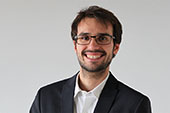
We congratulate Tobias Bauer (AK Barz, JGU) for being elected as new MAINZ Student Representative. He follows in line of succession Marius Bauer (AK Basché, JGU) who did a great job in the previous year. We highly appreciate Marius' input and effort to improve MAINZ Graduate School and wish him all the best for his future.
10.12.2018
MAINZ PI POL BESENIUS SELECTED FOR ERC CONSOLIDATOR GRANT
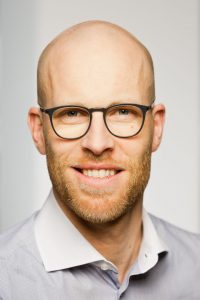
MAINZ PI Pol Besenius has been selected for an ERC Consolidator Grant with a project on „Supramolecular engineering of glycandecorated peptides as synthetic vaccines“ (SUPRAVACC). The European Research Council (ERC), set up by the European Union in 2007, is the premiere European funding organisation for excellent frontier research. Every year, it selects and funds the very best, creative researchers of any nationality and age, to run projects based in Europe. Congratulations!
Further information can be found at: https://erc.europa.eu/news/erc-2018-consolidator-grants-results.
2nd Massive Open Online Course on Spintronics online
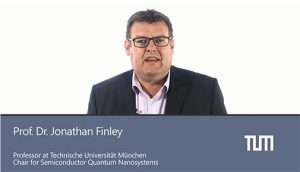 The second MAINZ spintronics MOOC by Jonathan Finley (TUM) is online. The online lecture series is focused on spintronics, one of the core research areas of the physics department and the Graduate School of Excellence Materials science in MAINZ. The format allows the students to self-pace the learning process, and repeat the lectures if needed. References are provided as a complementary material for each lecture. At the end of each lecture the student is presented with a set of closed-ended questions relative to the topic just described. This is meant to provide the student with an immediate assessment of the learning experience. The course is accessed by http://bit.ly/2gR2woJ (login as ‘guest’, university, or openOLAT account).
The second MAINZ spintronics MOOC by Jonathan Finley (TUM) is online. The online lecture series is focused on spintronics, one of the core research areas of the physics department and the Graduate School of Excellence Materials science in MAINZ. The format allows the students to self-pace the learning process, and repeat the lectures if needed. References are provided as a complementary material for each lecture. At the end of each lecture the student is presented with a set of closed-ended questions relative to the topic just described. This is meant to provide the student with an immediate assessment of the learning experience. The course is accessed by http://bit.ly/2gR2woJ (login as ‘guest’, university, or openOLAT account).MAINZ Member Matthias Barz receives the "Dozentenpreis des Fonds der Chemischen Industrie“
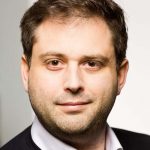 MAINZ Alumnus and current Associated Member Matthias Barz receives the "Dozentenpreis des Fonds der Chemischen Industrie“. This award is one of the most important young faculty awards in Chemistry in Germany. Congratulations!
MAINZ Alumnus and current Associated Member Matthias Barz receives the "Dozentenpreis des Fonds der Chemischen Industrie“. This award is one of the most important young faculty awards in Chemistry in Germany. Congratulations!MAINZ PhD Student Weixiang Ye awarded with Abstract Prize at ANNIC 2018
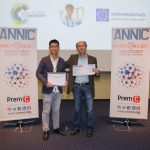 In the framework of the Applied Nanotechnology and Nanosciences Internations Conference (“ANNIC”) 2018 MAINZ PhD Student Weixiang Ye was awarded with the Best Student Award sponsored by MDPI Nanomaterials, the Molecular Systems Design & Engineering and to the Nanoscale Horizon journals. Congratulations!
In the framework of the Applied Nanotechnology and Nanosciences Internations Conference (“ANNIC”) 2018 MAINZ PhD Student Weixiang Ye was awarded with the Best Student Award sponsored by MDPI Nanomaterials, the Molecular Systems Design & Engineering and to the Nanoscale Horizon journals. Congratulations!Publications Highlight in Nano Letters with MAINZ PhD Student Weixiang Ye as Co-Author
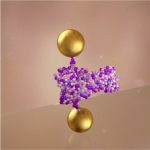 The function of proteins – the molecular tools of the cell – is governed by the interplay of their structure and dynamics. Advances in electron microscopy have now enabled scientists to capture structural information in amazing detail, but it is still difficult to monitor protein dynamics, especially over long periods of time. A team led by Prof. Dr. Thorsten Hugel from the Institute of Physical Chemistry and the BIOSS Centre for Biological Signalling Studies at the University of Freiburg and Prof. Dr. Carsten Sönnichsen from the Johannes Gutenberg University Mainz have used a new method to record the dynamics of individual proteins in action over 24 hours. Comparable measurements were previously only possible for a few seconds. They describe their approach and results in an article in the journal Nano Letters.The researchers attached two gold nanoparticles to the protein of interest and observed the distance-dependent interaction of the gold spheres using laser beams. The stability of this molecular assembly makes it possible to create a video of the movement of the protein over a whole day. Thus, it extends the previously achievable measuring range of other single-molecule measurements by several orders of magnitude and enables researchers to ask new types of questions. In future, it might be possible to test whether individual molecules display memory, or whether proteins with an identical chemical structure might behave differently over long periods of time.The biochemist and physicist Dr. Markus Götz worked in the Hugel laboratory at the University of Freiburg and is an expert on the heat shock protein Hsp90. Hsp90 is present in almost all cells in the human body and has important functions in many fundamental processes. For example, it plays a central role in the folding of linear amino acid chains into functional proteins with a precisely defined structure. "For the first time, we were able to observe the movements of Hsp90 over long periods of time. The significance of some newly discovered strikingly slow movements in Hsp90 is not yet fully understood," explains Hugel. Electrical engineer Weixiang Ye from the laboratory of Sönnichsen in Mainz has developed a greatly improved measurement setup for this project. It was important, for example, to reduce the huge amount of data collected during the 24-hour recording such that the recordings could be played back on normal computers. The biomedical chemists Sirin Celiksoy and Laura Tüting from the University of Mainz carried out the complex chemical tinkering that is required to specifically place a single protein between two tiny gold nanoparticles and ensure that the nanoparticles do not stick to one another.For this project, Hugel and his colleague Sönnichsen have both received prestigious grants from the European Research Council (ERC). "The ERC funding has enabled us to develop this project from the ground up before we were able – almost 10 years later – to make and analyse these measurements" says Sönnichsen. "None of us would have managed such a complex project on its own. The decisive factor was that we combined our respective expertise in Mainz and Freiburg." Based on the current results, Hugel and Sönnichsen are certain: "We want to continue and expand our collaboration.”
The function of proteins – the molecular tools of the cell – is governed by the interplay of their structure and dynamics. Advances in electron microscopy have now enabled scientists to capture structural information in amazing detail, but it is still difficult to monitor protein dynamics, especially over long periods of time. A team led by Prof. Dr. Thorsten Hugel from the Institute of Physical Chemistry and the BIOSS Centre for Biological Signalling Studies at the University of Freiburg and Prof. Dr. Carsten Sönnichsen from the Johannes Gutenberg University Mainz have used a new method to record the dynamics of individual proteins in action over 24 hours. Comparable measurements were previously only possible for a few seconds. They describe their approach and results in an article in the journal Nano Letters.The researchers attached two gold nanoparticles to the protein of interest and observed the distance-dependent interaction of the gold spheres using laser beams. The stability of this molecular assembly makes it possible to create a video of the movement of the protein over a whole day. Thus, it extends the previously achievable measuring range of other single-molecule measurements by several orders of magnitude and enables researchers to ask new types of questions. In future, it might be possible to test whether individual molecules display memory, or whether proteins with an identical chemical structure might behave differently over long periods of time.The biochemist and physicist Dr. Markus Götz worked in the Hugel laboratory at the University of Freiburg and is an expert on the heat shock protein Hsp90. Hsp90 is present in almost all cells in the human body and has important functions in many fundamental processes. For example, it plays a central role in the folding of linear amino acid chains into functional proteins with a precisely defined structure. "For the first time, we were able to observe the movements of Hsp90 over long periods of time. The significance of some newly discovered strikingly slow movements in Hsp90 is not yet fully understood," explains Hugel. Electrical engineer Weixiang Ye from the laboratory of Sönnichsen in Mainz has developed a greatly improved measurement setup for this project. It was important, for example, to reduce the huge amount of data collected during the 24-hour recording such that the recordings could be played back on normal computers. The biomedical chemists Sirin Celiksoy and Laura Tüting from the University of Mainz carried out the complex chemical tinkering that is required to specifically place a single protein between two tiny gold nanoparticles and ensure that the nanoparticles do not stick to one another.For this project, Hugel and his colleague Sönnichsen have both received prestigious grants from the European Research Council (ERC). "The ERC funding has enabled us to develop this project from the ground up before we were able – almost 10 years later – to make and analyse these measurements" says Sönnichsen. "None of us would have managed such a complex project on its own. The decisive factor was that we combined our respective expertise in Mainz and Freiburg." Based on the current results, Hugel and Sönnichsen are certain: "We want to continue and expand our collaboration.”More information can be found at: https://idw-online.de/de/news703628
MAINZ Vice Director Siegfried Waldvogel receives Heyrovsky Prize 2018
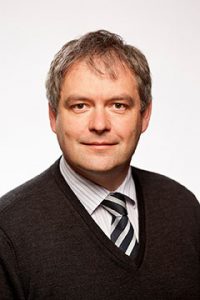 The Heyrovsky Prize is a Research Award of the International Society of Electrochemistry for outstanding work in the field of molecular electrochemistry. The next Heyrovsky Prize winner 2018 of the International Society of Electrochemistry will be the Mainz chemist Prof. Dr. Siegfried R. Waldvogel. Waldvogel is concerned with the use of electricity in the manufacture of valuable products, which is today traded under the buzzword Power-to-X. Waldvogel's scientific research activities over the last five years have been documented in more than 100 research papers, including premium journals. The application relevance is expressed in the same period by more than 30 initial patent applications. The research prize is named after the Czech scientist Jaroslav Heyrovsky, who received the Nobel Prize for Polarography in 1959, the basis of most electroanalytical methods.Foto/©: Eric Lichtenscheidt
The Heyrovsky Prize is a Research Award of the International Society of Electrochemistry for outstanding work in the field of molecular electrochemistry. The next Heyrovsky Prize winner 2018 of the International Society of Electrochemistry will be the Mainz chemist Prof. Dr. Siegfried R. Waldvogel. Waldvogel is concerned with the use of electricity in the manufacture of valuable products, which is today traded under the buzzword Power-to-X. Waldvogel's scientific research activities over the last five years have been documented in more than 100 research papers, including premium journals. The application relevance is expressed in the same period by more than 30 initial patent applications. The research prize is named after the Czech scientist Jaroslav Heyrovsky, who received the Nobel Prize for Polarography in 1959, the basis of most electroanalytical methods.Foto/©: Eric LichtenscheidtPublications Highlight in Nature with MAINZ PhD Student Andrew Ross as Co-Author
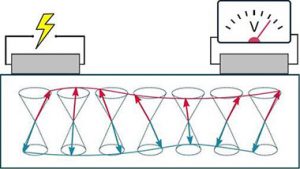 Conventional devices using current CMOS based technologies have the unwelcome side effects of getting too hot and being limited in their speed, operating at GHz frequencies. Eventually, this is slowing down the progress of information technology. In the last years, the emerging field of “magnon spintronics” aimed at using insulating magnets capable of carrying magnetic waves, known as magnons, to solve these problems. Magnons are able to carry information at increased speeds without the production of excess heat. However, experimental observations had so far been limited to ferromagnetic materials. In collaboration with the Quantum Spintronics at NTNU and Utrecht University, our group has demonstrated that magnons can also efficiently carry spin information in antiferromagnets, the largest group of magnetic materials. This class of material has several crucial advantages over ferromagnetic components as they are stable and unaffected by external magnetic fields, a key requirement for future data storage. Additionally, antiferromagnet based devices can be potentially operated thousands of times faster than current technologies, as their intrinsic dynamics are in the THz range. As a result, antiferromagnetic magnons could thus be used in future ultra-fast and low power technological devices.More information can be found at: https://www.nature.com/articles/s41586-018-0490-7
Conventional devices using current CMOS based technologies have the unwelcome side effects of getting too hot and being limited in their speed, operating at GHz frequencies. Eventually, this is slowing down the progress of information technology. In the last years, the emerging field of “magnon spintronics” aimed at using insulating magnets capable of carrying magnetic waves, known as magnons, to solve these problems. Magnons are able to carry information at increased speeds without the production of excess heat. However, experimental observations had so far been limited to ferromagnetic materials. In collaboration with the Quantum Spintronics at NTNU and Utrecht University, our group has demonstrated that magnons can also efficiently carry spin information in antiferromagnets, the largest group of magnetic materials. This class of material has several crucial advantages over ferromagnetic components as they are stable and unaffected by external magnetic fields, a key requirement for future data storage. Additionally, antiferromagnet based devices can be potentially operated thousands of times faster than current technologies, as their intrinsic dynamics are in the THz range. As a result, antiferromagnetic magnons could thus be used in future ultra-fast and low power technological devices.More information can be found at: https://www.nature.com/articles/s41586-018-0490-7Christian Berac elected as new MAINZ Student Represenative
 We congratulate Christian Berac (AK Besenius, JGU) for currently being elected as new MAINZ Student Representative. He follows in line of succession Mariia Filianina (AK Kläui, JGU) who did a great job in the previous year. We highly appreciate Mariia´s input and effort to improve MAINZ Graduate School and wish her all the best for her future.
We congratulate Christian Berac (AK Besenius, JGU) for currently being elected as new MAINZ Student Representative. He follows in line of succession Mariia Filianina (AK Kläui, JGU) who did a great job in the previous year. We highly appreciate Mariia´s input and effort to improve MAINZ Graduate School and wish her all the best for her future.MAINZ Visiting Professorships 2018 for Anna I. Krylov from the University of Southern California, USA, and Klaas-Jan Tielrooij from the Institute of Photonic Sciences in Spain
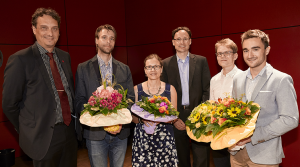 The Graduate School of Excellence Materials Science in Mainz (MAINZ) at Johannes Gutenberg University Mainz (JGU) has awarded visiting professorships to two outstanding scientists. The MAINZ Visiting Professorships 2018 were presented at a gala event to Professor Anna I. Krylov, a theoretical chemist at the University of Southern California, USA, and to Dr. Klaas-Jan Tielrooij, a physicist at the Institute of Photonic Sciences in Barcelona, Spain. Visiting professorships were established by MAINZ to attract foreign scientists to the various departments of the Graduate School so they can do part of their research here and work with the doctoral candidates studying at MAINZ. Their input can take the form of lectures, seminars, and workshops that help in training doctoral candidates at MAINZ. The MAINZ Visiting Professorships have been awarded annually since 2013.Anna I. Krylov, University of Southern California, USAProfessor Anna Krylov is an internationally renowned scientist in the area of theoretical chemistry. She is particularly well known for her many contributions dealing with method development in quantum chemistry as well as state-of-the-art applications of quantum chemistry to pending chemical problems. Her focus is on electron correlation and the treatment of electronically challenging states (radicals, excited states, etc.) using coupled-cluster and equation-of-motion coupled-cluster methods. Anna Krylov received the Bessel Research Award from the Alexander von Humboldt Foundation in 2011 and is a member of the International Academy of Quantum Molecular Science since 2015.Klaas-Jan Tielrooij, Institute of Photonic Sciences, SpainDr. Klaas-Jan Tielrooij is a highly multidisciplinary scientist with a track record across the fields of ultrafast phenomena, nanotechnology, and graphene and related 2D layered materials. He received the FOM Physics Thesis Award 2011 for his PhD research at AMOLF in Amsterdam and holds a degree in Innovation and Entrepreneurship from Chalmers University as well as a postgraduate diploma in Economics from the London School of Economics. He joined the Institute of Photonic Sciences in Barcelona in 2011 with an NWO Rubicon grant. Here he combines studying fundamental physics with identifying potential applications in the fields of photodetection, quantum technologies, and telecommunications.
The Graduate School of Excellence Materials Science in Mainz (MAINZ) at Johannes Gutenberg University Mainz (JGU) has awarded visiting professorships to two outstanding scientists. The MAINZ Visiting Professorships 2018 were presented at a gala event to Professor Anna I. Krylov, a theoretical chemist at the University of Southern California, USA, and to Dr. Klaas-Jan Tielrooij, a physicist at the Institute of Photonic Sciences in Barcelona, Spain. Visiting professorships were established by MAINZ to attract foreign scientists to the various departments of the Graduate School so they can do part of their research here and work with the doctoral candidates studying at MAINZ. Their input can take the form of lectures, seminars, and workshops that help in training doctoral candidates at MAINZ. The MAINZ Visiting Professorships have been awarded annually since 2013.Anna I. Krylov, University of Southern California, USAProfessor Anna Krylov is an internationally renowned scientist in the area of theoretical chemistry. She is particularly well known for her many contributions dealing with method development in quantum chemistry as well as state-of-the-art applications of quantum chemistry to pending chemical problems. Her focus is on electron correlation and the treatment of electronically challenging states (radicals, excited states, etc.) using coupled-cluster and equation-of-motion coupled-cluster methods. Anna Krylov received the Bessel Research Award from the Alexander von Humboldt Foundation in 2011 and is a member of the International Academy of Quantum Molecular Science since 2015.Klaas-Jan Tielrooij, Institute of Photonic Sciences, SpainDr. Klaas-Jan Tielrooij is a highly multidisciplinary scientist with a track record across the fields of ultrafast phenomena, nanotechnology, and graphene and related 2D layered materials. He received the FOM Physics Thesis Award 2011 for his PhD research at AMOLF in Amsterdam and holds a degree in Innovation and Entrepreneurship from Chalmers University as well as a postgraduate diploma in Economics from the London School of Economics. He joined the Institute of Photonic Sciences in Barcelona in 2011 with an NWO Rubicon grant. Here he combines studying fundamental physics with identifying potential applications in the fields of photodetection, quantum technologies, and telecommunications.
Photo:
(fltr) JGU Vice President Stefan Müller-Stach, MAINZ Visiting Professor Klaas-Jan Tielrooij, MAINZ Visiting Professor Anna I. Krylov, MAINZ Director Mathias Kläui, MAINZ awardee Hagen Söngen, and MAINZ awardee Philipp Heller
photo/©: Frank Wiedemeier, MAINZ
Contact:
Dr. Michael Fuchs
General Manager
Graduate School of Excellence Materials Science in Mainz (MAINZ)
Johannes Gutenberg University Mainz
55099 Mainz, GERMANY
phone +49 6131 39-26984
fax +49 6131 39-26983
e-mail: mainz@uni-mainz.de
http://www.mainz.uni-mainz.de
http://www.mainz.uni-mainz.de/2562.php
Scientists, incl. MAINZ PhD student Sven Otto, develop highly sensitive molecular optical pressure sensors
 An international team of chemists headed by Professor Katja Heinze at the Johannes Gutenberg Universites Institute of Inorganic Chemistry and Analytical Chemistry in Mainz and Professor Christian Reber at the Université de Montréal in Canada have developed a molecular system capable of very precise optical pressure measurements. The gemstone ruby served as the source of inspiration, but the new system is not only capable to detect pressure changes more than twenty times smaller but also soluble in water and organic sovents.
An international team of chemists headed by Professor Katja Heinze at the Johannes Gutenberg Universites Institute of Inorganic Chemistry and Analytical Chemistry in Mainz and Professor Christian Reber at the Université de Montréal in Canada have developed a molecular system capable of very precise optical pressure measurements. The gemstone ruby served as the source of inspiration, but the new system is not only capable to detect pressure changes more than twenty times smaller but also soluble in water and organic sovents.The chromium(III) complex, also called “molecular ruby”, has potential applications in the fields of materials sciences, homogeneous and heterogeneous catalysis, and all conceivable fields where pressure changes need to be monitored. The research findings have recently been published in Angewandte Chemie International Edition.
Sophisticated pressure-dependent luminescence measurements performed by Sven Otto during his secondment in Montréal in conjunction with ligand field and high level ab initio calculations allowed to further understand the influence of hydrostatic pressure on the optical properties of luminescent materials.
Johannes Gutenberg University Mainz ranked number 1 in the natural sciences in Germany in the 2018 DFG Funding AtlasJGU leads the list of higher education institutions with the highest DFG awards for 2014 to 2016 / Well ahead in funding per capita and in the discipline of physicsIn the 2018 DFG Funding Atlas published today by the German Research Foundation (DFG), Johannes Gutenberg University Mainz (JGU) tops the rankings in the natural sciences, ahead of the universities of Hamburg and Bonn. JGU received the highest volume of DFG funding in the natural sciences – some EUR 70 million in total – in the period 2014 to 2016, which is more than any other German university. Compared to the previous three years, this represents an increase of more than 80 percent and an improvement of 13 positions in the national ranking. Remarkably, JGU leads by an even greater margin in the ranking based on funds allocated per researcher, in this case ahead of the Humboldt-Universität zu Berlin. According to the 2018 Funding Atlas, JGU ranks among the institutions with an overall profile that places a strong focus on the natural sciences.
Physics at Mainz University has a large share in this success, namely with its PRISMA Cluster of Excellence and a DFG-funded collaborative research center (CRC) in the field of Particles, Nuclei and Fields as well as another CRC in the field of Condensed Matter Physics. Both research areas of JGU Physics are explicitly named in the 2018 Funding Atlas. In the field of physics alone JGU is leading nationwide by a significantly greater margin than in the natural sciences as a whole. Mainz University also achieved an outstanding placement in mathematics, which is ranked 9th.
"We are proud of the fact that JGU is at the top of all German universities in the natural sciences. This excellent success is affirmation of our great achievements, particularly those of our physicists and mathematicians in the key profile areas of our university," said Professor Georg Krausch, President of Johannes Gutenberg University Mainz. "This encourages us to persist with our profile-forming strategy and the associated expansion of cutting-edge university-based research based on specific projects." The success achieved by JGU in acquiring DFG funding is confirmed by the figures for European Research Council (ERC) funding in the years 2014 to 2016, which are also listed in the 2018 Funding Atlas. With four ERC grants in the natural sciences, JGU is in the leading group here as well. Only Heidelberg University with seven ERC grants and the University of Cologne and the Technical University of Munich with five ERC grants each were able to win more funding for top researchers.
JGU has also proved successful in the humanities and social sciences, where it improved its ranking by five places to 17th. The humanities even managed a solid 13th place. At a total of almost EUR 22 million in funding from 2014 to 2016, DFG funding for Johannes Gutenberg University Mainz was some EUR 4 million higher than in the previous three years. "Given our financial position, which is below the national average, this is a considerable achievement," concluded Krausch.Contact
Petra Giegerich
Head of Press and Public Relations
Johannes Gutenberg University Mainz
55099 Mainz
Tel.: +49 6131 39-22369
Fax: +49 6131 39-24139
presse@uni-mainz.de
MAINZ Visiting Professor Klaas-Jan Tielrooij highlighted in Science Advance
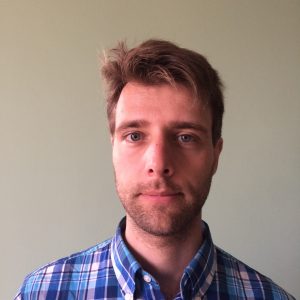 The photoexcited graphene puzzle solved
The photoexcited graphene puzzle solvedA boost for graphene-based light detectors
Light detection and control lies at the heart of many modern device applications, such as the camera you have in your phone. Using graphene as a light-sensitive material for light detectors can offer significant improvements with respect to materials being used nowadays. For example, graphene can detect light of almost any colour, and it gives an extremely fast electronic response within one millionth of a millionth of a second. Thus, in order to properly design graphene-based light detectors it is crucial to understand the processes that take place inside the graphene after it absorbs light.Mainz researchers Dr. Hai Wang, Prof. Dmitry Turchinovich, Prof. Mathias Kläui, and Prof. Mischa Bonn, in collaboration with scientists from various European labs, have now succeeded in understanding these processes. The project was led by Dr. Klaas-Jan Tielrooij from ICFO in Spain, who was recently elected as visiting professor at the Graduate School of Excellence “Materials Science in Mainz” (MAINZ).Published recently in Science Advances, their work gives a thorough explanation of why, in some cases, the graphene conductivity increases after light absorption and in other cases, it decreases. The researchers show that this behaviour correlates with the way in which energy from absorbed light flows to the graphene electrons: After light is absorbed by the graphene, the processes through which graphene electrons heat up happen extremely fast and with a very high efficiency.For highly doped graphene (where many free electrons are present), ultrafast electron heating leads to carriers with elevated energy – hot carriers – which, in turn, leads to a decrease in conductivity. Interestingly enough, for weakly doped graphene (where not so many free electrons are present), electron heating leads to the creation of additional free electrons, and therefore an increase in conductivity. These additional carriers are the direct result of the gapless nature of graphene – in gapped materials, electron heating does not lead to additional free carriers.This simple scenario of light-induced electron heating in graphene can explain many observed effects. Aside from describing the conductive properties of the material after light absorption, it can explain carrier multiplication, where – under specific conditions – one absorbed light particle (photon) can indirectly generate more than one additional free electron, and thus create an efficient photoresponse within a device.The results of the paper, in particular, understanding electron heating processes accurately, will definitely mean a great boost in the design and development of graphene-based light detection technology.REFERENCE
The ultrafast dynamics and conductivity of photoexcited graphene at different Fermi energies
Science Advances
A. Tomadin, S.M. Hornett, H.I. Wang, E.M. Alexeev, A. Candini, C. Coletti, D. Turchinovich, M. Kläui, M. Bonn, F.H.L. Koppens, E. Hendry, M. Polini and K.J. TielrooijFUNDING INFO
This work was funded by the E.C. under Graphene Flagship, as well as a Mineco Young Investigator grant.CONTACT
Klaas-Jan Tielrooij, klaas-jan.tielrooij@icfo.eu, +34691361210
Andrea Tomadin, andrea.tomadin@mac.com
MAINZ Summary 2014-2016 fresh from the printer
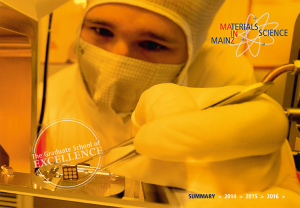 Finally, the newest MAINZ Summary, spanning the years 2014, 2015 and 2016, is out in its printed version and ready for download. We want to thank all of you that contributed to the Summary with your profiles, testimonials, photos and feedback!
Finally, the newest MAINZ Summary, spanning the years 2014, 2015 and 2016, is out in its printed version and ready for download. We want to thank all of you that contributed to the Summary with your profiles, testimonials, photos and feedback!Physicists modify the atomic interaction in ultracold matter
Physicists at the Technische Universität Kaiserslautern (TUK) under the leadership of Professor Dr. Herwig Ott have succeeded for the first time in changing the interaction between two atoms in ultracold matter with the aid of so-called Rydberg molecules. These recently discovered large molecules consist of only two atoms whose binding mechanism cannot be described with common chemical models. They have extraordinary properties such as a long bond length. The study has now been published in the renowned journal "Nature Communications".
Interactions are the fundamental master builder of our world. Not only in social life, but also in the matter that surrounds us. As early as the beginning of the 20th century, the physicist Ernest Rutherford discovered that even gold consists of more than 99 percent nothing. Only the interaction of individual particles makes matter what it is. It keeps our world together at its core.
This applies not only to our everyday world, but also to the world of quantum physics. Physicists often use ultracold atomic gases to investigate quantum phenomena. "Temperatures are around absolute zero, which means -273 degrees Celsius," says Professor Dr. Herwig Ott, who is conducting research at the TUK on ultracold quantum gases and quantum atom optics. "The behavior of atomic gases is determined by the interaction between atoms." In this context, experts also speak of a quantum mechanical scattering process. "Such gases are of great importance to science when investigating quantum mechanical effects, because these interactions can be changed in the laboratory," the professor continues.
This is usually not the case with the matter that surrounds us in everyday life. "The water molecules in a glass of water, for example, always have the same interaction and the question of what would be the properties of water if the water molecules were to attract twice as much cannot be answered experimentally," said the physicist.
The scientists around Professor Ott have now succeeded for the first time in changing the interaction between ultracold atoms with the aid of so-called Rydberg molecules. The idea for this experiment: Two atoms that collide are briefly put into a state corresponding to one molecule by means of a laser beam. "This allows them to remain together for a long time," explains the professor. "This alters the quantum mechanical scattering process between the two atoms and thus the interaction between them."
The researchers in Kaiserslautern were now able to observe this in experiments: Therefore, they "built" a Rydberg molecule from two rubidium atoms. This form of the molecules was discovered only a few years ago. These molecules can be as large as viruses but consist of only two atoms. As a rule, molecules consisting of two atoms are much smaller. In contrast to previously known bonds, in which, for example, two atoms each divide one electron, a different mechanism works here: An electron has only a very weak bond to the atomic nucleus and is located on an outer electron path, it is in a so-called Rydberg state. The second atom now experiences a quantum mechanical interaction with the electron and a weak bond is formed between the two atoms.
"These molecules have a number of extraordinary properties," said the professor, "such as their extremely long bond length of several hundred nanometers and their very large electrical dipole moments." Science understands this as the fact that molecules can have a spatially separated positive and negative charge.
The results of the scientists from Kaiserslautern make it possible to change the interaction in almost any ultracold gas. On the other hand, they also open up new application possibilities such as the direct control of multi-particle interactions. "But interactions with longer ranges than previously possible can also be induced in the future," cites the physicist as a further example. "This could enable new states of matter to be realized in ultracold gases in the future."
The study has now been published in the renowned journal "Nature Communications": „Experimental realization of a Rydberg optical Feshbach resonance in a quantum many-body system“; O. Thomas, C. Lippe, T. Eichert & H. Ott
DOI: https://doi.org/10.1038/s41467-018-04684-w
The work was financed by the State Research Centre for Optics and Materials Science (OPTIMAS), the Graduate School "Materials science IN MainZ" (MAINZ) and the two special research areas "Condensed Matter Systems with Variable Many-Body Interactions" and "OSCAR - Open System Control of Atomic and Photonic Matter".
PUBLIC RELATIONS
Public Relations
Gottlieb-Daimler-Straße 47
67663 KaiserslauternPhone: +49(0)631/205-4367
E-Mail: presse@uni-kl.de
www.uni-kl.deQuestions can be directed to:
Prof. Dr. Herwig Ott
Phone: 0631 205- 2817
E-mail: ott@physik.uni-kl.de
With tiny particles against major diseases
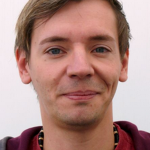
Mainz scientists fight fungal disease on vines with nanotechnologyFungal disease of crop plants causes millions of Euros of agricultural damage every year. Often they cannot or only hardly be medicated by commercial chemical protection. Scientists around Priv.-Doz. Dr. Frederik R. Wurm of the Max Planck Institute for Polymer Research (MPI-P, Department of Prof. Dr. Katharina Landfester) in Mainz, Germany, are developing a nanotechnology-based protection with minimal use of active agent, which avoids excessive spraying of fungicides. In cooperation with the “Institute for Biotechnology and Drug Research” and the Institute for Crop Protection in Neustadt a. d. Weinstraße (DLR), the project went into the next phase: The technology was applied to a test vineyard of the DLR....
Uday Chopra admitted as new member of the Gutenberg Academy
 We are very proud to announce that MAINZ PhD Student Uday Chopra (AK Sinova, JGU) is among the new members of the Gutenberg Academy for Young Researchers. Congratulations! He was admitted to the academy in a ceremony on April 23 together with 11 other PhD students from all scientific disciplines at JGU. The academy brings together up to 25 of JGU's best PhD students and artists and provides them with the chance to participate in an interdisciplinary exchange of ideas at the highest intellectual level....
We are very proud to announce that MAINZ PhD Student Uday Chopra (AK Sinova, JGU) is among the new members of the Gutenberg Academy for Young Researchers. Congratulations! He was admitted to the academy in a ceremony on April 23 together with 11 other PhD students from all scientific disciplines at JGU. The academy brings together up to 25 of JGU's best PhD students and artists and provides them with the chance to participate in an interdisciplinary exchange of ideas at the highest intellectual level....03.04.2018
Highlight Publication by Lisa Dreier in Science Advances
Saturation of Charge-Induced Water Alignment at Model Membrane Surfaces
The primary building blocks of biological membranes are lipids. The water molecules present at these membrane interfaces are oriented by the charged headgroups of the lipid molecules. A combined theoretical and experimental approach shows that there is a critical charge density above which the water molecules stop responding to the increase in charge. The insensitivity of the water molecules to the increase in charge can be traced to molecular rearrangement occurring at the lipid interface, in combination with the adsorption of counterions. These findings have important implications for reactions occurring at biological membranes. ...
26.03.2018
MAINZ Award 2017 goes to Philipp Heller and Hagen Söngen
Philipp Heller (left) and Hagen Söngen (right) are the awardees of the MAINZ Awards 2017.
The awards will be presented in the annual MAINZ Award Ceremony on July 19, 2018 together with the MAINZ Visiting Professorships 2018. ...
26.03.2018
Anna I. Krylov and Klaas-Jan Tielrooij selected for MAINZ Visiting Professors 2018
Anna I. Krylov (University of Southern California, USA) and Klaas-Jan Tielrooij (The Institute of Photonic Sciences, Spain) were selected to become MAINZ Visiting Professors 2018.
The MAINZ Visiting Professorships will be awarded in the MAINZ Award Ceremony on July 19, 2018 when the professorships will also be officially announced to the broader public. ...
16.03.2018
Kläui Lab: Publications Highlight in Nature Communications
The implementation of logic operations and thus information processing by means of spin wave (magnon) spin currents is a fundamental goal of the emerging research field of magnon spintronics. In contrast to electrical currents, on which todays information technology is based, magnon spin currents do not conduct electrical charges but magnetic momenta. So far, experimental demonstrations of magnon logic, e.g. a magnon transistor or majority gate, were based on either the manipulation or superposition of spin waves during the propagation phase. In a collaboration with the group of Prof. Ulrich Nowak from the University of Konstanz and Prof. Eiji Saitoh from the Tohoku University in Sendai, Japan, the group of Prof. Mathias Kläui was now able to add a further element to the construction set of magnon logic directly at the detection site of magnon spin currents. In a ferroic spin valve structure including insulating as well as metallic ferromagnets and antiferromagnets, it was possible to demonstrate a magnon detection efficiency which depends on the magnetic configuration of the spin valve. In that manner, the suppression or transmission of the incoming magnon signal can be controlled.
More detailed information can be found in the publication in Nature Communications accessible at: doi:10.1038/s41467-018-03485-5
Press release:
http://www.uni-mainz.de/presse/aktuell/32_ENG_HTML.php (english) ...
19.02.2018
Volkswagen Foundation supports research of MAINZ member Frederik Wurm
The Volkswagen Foundation (VolkswagenStiftung) has selected the interdisciplinary project “NanoProtect” of Dr Frederik Wurm, head of the Functional Polymers research group at the Max Planck Institute (MPI) for Polymer Research in Mainz, Germany for its funding initiative 'Experiment!'. Wurm’s research is focussing on the design and development of degradable polymers and nanocarriers (please also visit www.chemistry-is-life.de). “NanoProtect” is an innovative collaboration project together with biology partners to fight against plant diseases, which cannot be cured to date. The project is realized by an interdisciplinary consortium of three German institutes including the MPI for Polymer Research. ...
07.02.2018
Former MAINZ PhD student Felix Büttner receives IEEE Best Young Researcher Award
Felix Büttner received at the 2018 Advances in Magnetics Conference organized by the Italian Section of the IEEE the Best Young Researcher Award. He was picked from 5 finalists that were selected to present invited talks at a special Young Researchers Session of the conference based on his major achievements in the field of chiral spin structures and spin dynamics. Felix Büttner was a member of the Graduate School of Excellence Materials Science in Mainz and received his PhD at the end of 2013 on Nanomagnetism and Spin Dynamics. He is currently a postdoctoral researcher at the Massachusetts Institute of Technology. ...
30.01.2018
MAINZ Visiting Professor Bert Meijer is new external faculty member at MPI-P
The appointment of Bert Meijer broadens materials scope of Max Planck Institute (MPI) for Polymer Research for supramolecular materials and medical applications.
Bert Meijer was awarded with the MAINZ Visiting Professorship in 2016 and already hosted a successful MAINZ Master Class with Pol Besenius in 2017 and gave recently a Public Lecture on "Why we can´t make life". ...
19.01.2018
MAINZ Coordination Office Team awarded with "JGU Leadership Team Award"
The team of the MAINZ Coordination Office was now officially awarded with the "JGU Leadership Award by Prof. Georg Krausch, president of Johannes Gutenberg University Mainz. ...
10.01.2018
Marius Bauer elected as new MAINZ Student Representative
MAINZ students voted again for a new Student Representative. Marius Bauer was elected for a year to represent our students in the Steering and Selection Committee together with Mariia Filianina who was elcted 6 months ago. To the previous Student Representative Christoph Gamer we say our special thanks for his commitment! ...
MAINZ Coordination Office wins JGU Leadership Team Award
The team of the Coordination Office of the Graduate School Materials Science in Mainz (MAINZ) is awarded with the JGU Leadership Team Award 2017 for its teamwork and implementation of JGU´s leadership guidelines. Important criteria for the award committee were communication and social intercourse within the team, team meetings and team building measures, amongst others. We are very happy to receive this recognition and we will continue to work on our good spirit and motivation in the team. ...
01.12.2017
Karin Everschor-Sitte awarded with Hertha-Sponer-Prize 2018
MAINZ Associate Member Karin Everschor-Sitte won the Hertha-Sponer-Prize 2018 by DPG for her research on theoretical understanding of skyrmions.
29.11.2017
Frederik Wurm receives Lecturer Award of the German Chemical Industry Fund
MAINZ Alumnus and Associate Member Frederik Wurm was awarded with the Lecturer Award for his outstanding achievements in research and teaching.
29.11.2017
JGU signs agreement on student exchange between the Graduate School MAINZ and the MINT center at the University of Alabama
Following its aim to foster international exchange, the Graduate School Materials Science in Mainz (MAINZ) has signed an MoU with the Center for Materials for Information Technology (MINT) at the University of Alabama. The MoU covers the exchange of students as well as faculty and staff members. It also includes the promotion of joint research activities.
The MINT Center was founded in 1988 as a multidisciplinary research program focusing on new materials for advanced data storage. A major emphasis is on materials for magnetic heads and media, key components in high performance information storage systems. More than 30 faculty from seven academic programs including Chemical Engineering, Chemistry, Electrical Engineering, Materials Science, Mathematics, Metallurgical and Materials Engineering, and Physics work together to provide students with a broad training in materials performed in a team environment. Research carried out in cooperation with industrial partners prepares students for exciting careers in a rapidly expanding field.
The Center for Materials for Information Technology at the University of Alabama is one of the leading research centers in the U.S., and, according to its mission, performs world-class research, educates students, and serves as a resource and communication channel for the information storage industry. Research programs range from the most fundamental studies of spintronic materials and phenomena to the technologies of information storage systems. Basic science, supported by strong materials preparation and characterization facilities, is focused on future opportunities for materials breakthroughs. Promising results are transferred to our industry partners through collaborative research programs. An infrastructure of exchange visits and visitors, seminars, workshops, industrial internships, and research reviews facilitate a dynamic approach for information growth.
For student exchange, the MINT center offers a summer internship program (SIP) which offers international graduate students the opportunity to participate in materials research projects during the summer months. Students will work on a specific research project in close collaboration with faculty, post doctorates and other graduate students. Seminars, lunches and other social events will be organized to enable students to broaden their knowledge and socialize with their interdisciplinary collaborators at the MINT center.
The Graduate School of Excellence Materials Science in Mainz (MAINZ) is an international PhD program which focuses on graduate training through excellence in research. MAINZ provides a comprehensive graduate program combining two elements: Training through Research and Training for Life. MAINZ offers the following programs: a full PhD program including a fast-track option; a guest PhD program for international PhD students; and a student internship program for international BSc/MSc students. MAINZ is funded by the German Research Foundation (DFG) in the framework of the Excellence Initiative. Students from the University of Alabama will be hosted by MAINZ either in the Guest PhD Program or in the Student Internship Program.
Links:
MINT Center:
https://mint.ua.edu/
Graduate School MAINZ:
http://www.mainz.uni-mainz.de/
Summer Internship Program (SIP) of the MINT center:
https://mint.ua.edu/education/mint-summer-internship-program/
MAINZ Guest PhD Program:
http://www.mainz.uni-mainz.de/2456.php
MAINZ Internship Program:
http://www.mainz.uni-mainz.de/Internship.php
14.11.2017
Karin Everschor-Sitte highlighted in DFG-Magazine
25.10.2017
MAINZ Award 2016 goes to Jana Herzberger and Lalita Shaki Uribe Ordonez
Every year the MAINZ Award is granted for two outstanding PhD theses. Former PhD students who achieve a degree "with distinction" (summa cum laude) and manage to complete the MAINZ certificate are candidates for nomination by their supervisors.
The recipients of the MAINZ Award 2016 are Jana Herzberger (left) and Lalita Shaki Uribe Ordonez (right).
Jana Herzberger receives the MAINZ Award 2016 for her thesis on "Polyethers with tunable properties from tailored amino functional epoxides". Jana studied Chemistry at JGU including a stay as exchange student researcher at the University of Massachusetts – Amherst (USA). Following an internship with BASF in Wyandotte, MI, USA, she started her PhD in the group of Holger Frey at JGU including a secondment at the Université de Bordeaux. Jana received a fellowship from VCI, was member of Gutenberg Academy and participated in the BASF Mentoring Program "Discover Together". She contributed to MAINZ as an organizer of two summer schools. Jana now works as a PostDoc at the Virginia Polytechnic Institute and State University.
Lalita Shaki Uribe Ordonez studied Chemistry at Universidad Nacional de Colombia in Bogotá. Supported by an Erasmus Mundus fellowship, she obtained a Master in Theoretical Chemistry within the "European Master in Theoretical Chemistry and Computational Modeling" Program at Università degli Studi di Perugia (Italy) which included a research stay at Université Toulouse. She then joined MAINZ and the group of Jürgen Gauß working on "Molecular Dynamics Study of the Mechanical Properties of Foldamers and the Metal Specificity of an Isatin Hydrolase". She gained further international experience on a secondment at Universitete i Oslo (Norway). Lalita was MAINZ PhD Student Representative in 2015 and now works at SAP.
25.10.2017
MAINZ Visiting Professorships 2017 awarded to Adam Foster, Eiji Saitoh and Roberta Sessoli
The Graduate School of Excellence Materials Science in Mainz (MAINZ) has again awarded visiting professorships to three outstanding scientists. The MAINZ Visiting Professorships 2017 were presented at a gala event to Professor Adam Foster, a physicist of Aalto University, Helsinki, Finland, to Professor Eiji Saitoh, a physicist of Tohoku University, Sendai, Japan, and to Professor Roberta Sessoli, a chemist of Università di Firenze, Italy. Visiting professorships were established by MAINZ to attract foreign scientists to the various departments of the Graduate School so they can do part of their research here and work with the doctoral candidates studying at MAINZ. Their input can take the form of lectures, seminars, and workshops that help in training doctoral candidates at MAINZ. The visiting professorships have been awarded annually since 2013.
Adam Foster, Aalto University, Helsinki, Finland
Adam Foster is a theoretical physicist working in the field of surface and interfacial science. Already during his time as PhD student at University College London, he contributed substantially to understanding the role of defects in bulk oxide materials. His research has attracted numerous citations, and he is author of pivotal review articles, addressing defects in wide band gap as well as high-k materials. He his tenured professor at Aalto University where he is heading the “Surface and Interfaces at the Nanoscale” simulation group and director of the Aalto Education Network in Condensed Matter Physics. His dedication to graduate education is reflected in unconventional teaching and meeting formats and an open discussion culture.
Eiji Saitoh, Tohoku University, Sendai, Japan
Eiji Saitoh is a pioneer of spin-current physics. By discovering many major phenomena in the field, such as the inverse spin Hall effect (ISHE) and the spin Seebeck effect (SSE), he forged the foundations of spin-current science and what is now called spin-caloritronics. Eiji Saitoh is committed to dissemination activities of spin current science: together with his colleagues he published one of the standard text books in the field of spin current science: “Spin current" (Oxford university press). Amongst many other awards, he has been chosen by the IEEE Magnetic Society to be the 2017 Distinguished Lecturer to give outreach talks highlighting the high quality of his presentations.
Roberta Sessoli, Università di Firenze, Italy
Roberta Sessoli is a pioneer in the field of molecular magnetism. Her research work on low dimensional molecular materials led to the breakthrough discovery that a few paramagnetic metal ions in a molecule can behave like a magnet. An ERC Advanced Grant allowed her to establish a new research team working at the interface between surface science and molecular magnetism. Roberta Sessoli was appointed a member of the Science and Technology Advisory Council created in 2012 by the President of the European Commission. In that function, she has contributed to the drafting of documents about science for an informed, sustainable and inclusive knowledge society and about science for the future of Europe.
photo/©: Maximilian Staab/MAINZ
Further information:
Dr. Michael Fuchs
General Manager
Graduate School of Excellence Materials Science in Mainz (MAINZ)
Johannes Gutenberg University Mainz
55099 Mainz, GERMANY
phone +49 6131 39-26984, fax +49 6131 39-26983
e-mail: mainz@uni-mainz.de ...
10.10.2017
Johannes Gutenberg University Mainz among the top 100 most innovative universities in the world
Only seven German universities listed in the top 100 of the World’s Most Innovative Universities ranking
Johannes Gutenberg University Mainz (JGU) achieves very good results in the international Reuters Top 100 – The World's Most Innovative Universities 2017 ranking. This is the first time that Mainz University is listed among the world's 100 most innovative universities with a good 91st place in the ranking. All in all, only seven German universities managed to claim a position in the top 100 of this ranking.
The Reuters Top 100 – World’'s Most Innovative Universities is a university ranking published by Thomson Reuters media group and aimed at identifying the 100 most innovative universities in the world from a pool of 600 research institutes. Rankings are based in particular on the universities' patent filings and their rate of success. JGU is especially well represented in the field of Pharmaceuticals & Biotech, hence its inclusion in the top 100.
Related links:
https://www.reuters.com/innovative-universities-2017
--
Press and Public Relations
Johannes Gutenberg University Mainz
55099 Mainz, GERMANY
phone +49 6131 39-22369
fax +49 6131 39-24139
e-mail: presse@uni-mainz.de ...
09.10.2017
Siegfried Waldvogel develops electro-organic synthesis that allows sustainable and green production of fine chemicals
MAINZ Vice Director: Innovative contribution to the energy transition
In the cooperative EPSYLON research project funded by the German Federal Ministry of Education and Research, scientists from Johannes Gutenberg University Mainz (JGU) and Evonik Performance Materials GmbH have succeeded in developing a state-of-the-art and innovative electro-organic synthesis. The results of their research, presented in last week's issue of Science Advances, allow the use of electrosynthesis as a trend-setting and sustainable green chemistry for technical applications. The method developed allows the operator to react flexibly to the available supply of electricity. Moreover, the operator no longer has to rely on customized electrolysis apparatuses and can use a wide variety of different equipment.
The method of carrying out chemical reactions using electricity was developed more than 160 years ago by German chemist Hermann Kolbe. Although electrochemical syntheses are used in the chemical industry, this has so far been a niche technology. One reason is that the electrolysis conditions must be very finely controlled and uniform current input is essential. Due to the sophisticated technical infrastructure, the option of electrosynthesis remained unknown to most chemists. Now, in the 21st century, the green potential of electrochemistry has been rediscovered. It makes sustainable and eco-friendly chemistry possible with very simple means, particularly with the use of surplus power from renewable sources, such as wind or solar energy.
Electrochemistry is a versatile and powerful method that can be used to produce various chemical compounds or to effect chemical changes in molecules. To put it simply, electrons replace costly and toxic reagents. Unnecessary wastes can be avoided and the reaction can be halted at any time by simply switching off the power. Another advantage over classical synthesis is that many individual steps are more easily implemented by electrochemistry. In some cases, this can shorten a synthesis by several steps. However, electrolyses often require a narrow current-density window and long reaction times. In addition, selectivity and scalability are more difficult or even impossible.
The key to the success of the research group headed by Professor Siegfried Waldvogel of the Institute of Organic Chemistry at Johannes Gutenberg University Mainz is the use of a unique electrolyte system. The electrolyses here have extremely high stability to variation in current density, allowing operation in a current-density window with a width extending over more than two orders of magnitude, with no loss of productivity or selectivity. If the supply of current permits, the electrolysis may be carried out in a short time with very high current density.
Publication:
A. Wiebe, B. Riehl, S. Lips, R. Franke, S. R. Waldvogel. Unexpected high robustness of electrochemical cross-coupling for a broad range of current density, Science Advances 2017, 3, eaao3920.
Contact:
Professor Dr. Siegfried Waldvogel
Institute of Organic Chemistry
Johannes Gutenberg University Mainz
e-mail: waldvogel@uni-mainz.de
http://www.chemie.uni-mainz.de/OC/AK-Waldvogel/
05.10.2017
Publication by MAINZ Alumnus Thomas Lenz highlighted in Applied Physics Letters - the work was a collaboration between biologists and medical doctors from University Medical Center Mainz and the Max Planck Institute for Polymer Research
29.09.2017
Good start into the German Excellence Strategy competition: Mainz University to submit full proposal for its PRISMA+ Clusters of Excellence
International expert committee approves the PRISMA+ proposal for the final round of the nationwide competition
Johannes Gutenberg University Mainz (JGU) started successfully in the Excellence Strategy competition of the German federal and state governments. JGU will enter the final round with a full proposal for the PRISMA+ Cluster of Excellence. The international expert committee of 39 researchers and scientists named by the German Joint Science Conference (Gemeinsame Wissenschaftskonferenz, GWK) has called on Johannes Gutenberg University Mainz to submit a follow-up proposal for its "Precision Physics, Fundamental Interactions, and Structure of Matter" (PRISMA) Cluster of Excellence, which had been successful already in the previous Excellence Initiative competition. "We are very happy that our draft proposal for PRISMA+ has been approved by the international advisory body. As we were up against stiff competition, the outcome confirms the international standing of our physicists here in Mainz", explained President of Johannes Gutenberg University Mainz, Professor Georg Krausch.
The Cluster of Excellence PRISMA+ is dedicated to exploring the most exciting questions in fundamental physics today such as the nature of dark matter and the existence of new particles and forces. PRISMA+ comprises high-profile research groups in the areas of astroparticle, particle, hadron and nuclear physics, as well as laser spectroscopy and physics with ultra-cold neutrons (UCN) and expands on the PRISMA Cluster of Excellence that already received funding from 2012 to 2017. Professor Matthias Neubert from the JGU Institute of Physics and Professor Hartmut Wittig from the JGU Institute of Nuclear Physics act as spokespersons of PRISMA+.
The flagship projects of PRISMA+ include the search for dark matter and axion-like particles, as well as investigations of neutrino properties. Another approach for exploring the limits of the Standard Model of particle physics consists in comparing precision measurements with theoretical predictions. JGU's innovative electron accelerator MESA is a centerpiece of the research program. MESA's extremely high beam current offers unique opportunities for measuring low-energy precision observables and exploring the dark sector. MESA will host the P2 experiment designed to search for signs of new physics via an extremely precise measurement of the electroweak mixing angle. The MAGIX spectrometer at MESA is capable of measuring proton form factors in a previously inaccessible range, making decisive contributions to the resolution of the proton radius puzzle. MAGIX will also search for messenger particles between dark and luminous matter, so-called dark photons, while the highly intense beam of MESA enables direct searches for dark matter with a new beam-dump experiment.
Another key experiment is the precision measurement of the neutron lifetime at JGU's TRIGA reactor using a new magnetic storage technique. PRISMA+ scientists are at the forefront of applying laser spectroscopy of trapped atoms to determine the charge radii of light nuclei and parity-violating observables, complementing the measurements at P2 and MAGIX. Exploring the properties of weakly interacting particles such as neutrinos, dark matter, and axions is another research focus of PRISMA+. Searches for dark matter and messenger particles will be performed at the XENON and ATLAS detectors. These activities are complemented by ultra-sensitive magnetometry experiments searching for axions. New research efforts in neutrino physics are focused on determining neutrino masses and mixing parameters. A cooperation agreement between Mainz University and Fermilab forms the basis for a joint initiative in accelerator-based neutrino physics, aimed at establishing CP violation in the neutrino sector.
The cluster will profit greatly from the scientific programs and workshops of the Mainz Institute for Theoretical Physics. PRISMA+ aims at connecting the internationally leading research environment with an ambitious and high-quality education and training program. The Mainz Physics Academy will create an umbrella structure for all measures in education, training, recruiting, and early-career support. Furthermore, PRISMA+ will promote women in science by significantly expanding the activities of the established Irène Joliot-Curie Program.
The German Research Foundation (Deutsche Forschungsgemeinschaft, DFG) received proposals for a total of 195 Clusters of Excellence. With today's decision, 88 proposals from 41 universities have entered the next round of the competition. The decision as to which projects will receive financial support for a seven-year period starting January 1, 2019 will be made in September 2018.
Press and Public Relations
Johannes Gutenberg University Mainz
55099 Mainz, GERMANY
phone +49 6131 39-22369
fax +49 6131 39-24139
e-mail: presse@uni-mainz.de ...
13.09.2017
Kristina Klinker: Multifunctional nano-sized drug carriers based on reactive polypept(o)ides
MAINZ student discovers: Secondary structure formation enables morphology control
Nano-sized carrier systems find medical application to improve pharmacologic properties of bioactive agents. For many therapeutic approaches, it is important that the carrier system can stably incorporate the cargo during circulation without inducing aggregation, while cargo should ideally only be released after successful cellular uptake. These requirements have thus far only been met by chemistry approaches with nanoparticles that are difficult to characterize. Consequently, clinical translation of these systems has been very difficult to achieve.
In cooperation with researchers from the University of Tokyo and Gutenberg Research Awardee Prof. Kazunori Kataoka, Chemists from Mainz have been able to demonstrate that reactive polypept(o)ides constitute ideal building blocks to control morphology and function of carrier systems in a simple but precise manner. Polypept(o)ides (polysarcosine-block-polypeptide copolymers) have emerged as interesting hybrid materials for drug carrier systems since they combine protein-resistance and high water-solubilty of polysarcosine with the stimuli-responsiveness, intrinsic multifunctionality, and secondary structure formation of polypeptides.
In this cooperative work, the researchers could show for the first time that the formation of β-sheets by the synthetic polypeptide segment can be exploited to deliberately manipulate the morphology of polymeric micelles (Klinker K et al. Angew. Chem. Int. Ed. 2017, 56 (32), 9608-9613 & Angew. Chem. 2017, 129 (32), 9737–9742), which enables the synthesis of either spherical or worm-like micelles from the same block copolymer. By employing reactive groups in the polypeptide segment of the block copolymer, micelles can be core cross-linked by dithiols, resulting in bio-reversible disulfide bonds. Due a difference in redox potential, disulfides are considered stable extracellularly, while they are rapidly reduced to free dithiols intracellularly, which leads to a disintegration of the carrier system and release of the cargo.
“In this way, a variety of different nanocarriers with different functions becomes readily accessible from one single block copolymer and a very selective post-polymerization step. This modular approach to nanoparticles with different function and morphology bears the advantage to address important questions with good comparability, such as the influence of size and shape on in vivo circulation times, biodistribution, tumor accumulation, cell uptake and therapeutic response since the same starting material is used” comments Matthias Barz.
First in vivo experiments have already demonstrated that these core-stabilized micellar nanocarriers exhibit stable circulation behavior, thus indicating that interactions with serum components or blood vessels are absent. Only by ensuring that no unspecific interactions occur within the complex biological setting, cellular uptake in desired specific cell populations seems feasible. The therapeutic potential of the described nanoparticle platform will be further investigated with regards to immunotherapy of malignant melanoma within the SFB 1066.
Publication:
Klinker K, Schäfer O, Huesmann D, Bauer T, Capelôa L, Braun L, Stergiou N, Schinnerer M, Dirisala A, Miyata K, Osada K, Cabral H, Kataoka K, Barz M*. Secondary Structure-Driven Self-Assembly of Reactive Polypept(o)ides: Controlling Size, Shape and Function of Core Cross-Linked Nanostructures. Angew. Chem. Int. Ed. 2017, 56 (32), 9608-9613
Further information:
Dr. Matthias Barz
Institute of Organic Chemistry
Johannes Gutenberg University Mainz
e-mail: barz@uni-mainz.de
http://www.ak-zentel.chemie.uni-mainz.de/
12.09.2017
MAINZ Associate Arash Nikoubashman highlighted in JGU Magazine
Arash Nikoubashman has been heading the Emmy Noether independent junior research group on "Controlled Transport and Assembly of Soft Complex Matter" since 1 October 2015. Read more on JGU Magazine ...
05.09.2017
Imaging how magnetism goes surfing
16.08.2017
MAINZ Vice Director Siegfried Waldvogel highlighted in JGU Magazine
With his team, Siegfried Waldvogel develops new methods to gain valuable resources from waste matters. Read more on JGU Magazine ...
31.07.2017
MAINZ Office welcomes back Nicole Plenz from maternity leave
Administrative Assistant Nicole Plenz rejoins the MAINZ Office after maternity leave. Welcome back! ...
26.07.2017
MAINZ Senior Member Kurt Binder and MAINZ Associate Arash Nikoubashman: New insights into nanosystems with spherical confinement
Theoretical physicists led by Professor Kurt Binder and Dr. Arash Nikoubashman at Johannes Gutenberg University Mainz (JGU) have used computer simulations to study the arrangement of stiff polymers in spherical cavities. These confined systems play an important role for a wide range of applications, such as the fabrication of nanoparticles for targeted drug delivery and for tailored nanomaterials. Furthermore, the investigated systems can give crucial insights into the inner workings of biological problems where confinement effects are crucial, such as the packaging of double-stranded DNA in bacteriophage capsids and the self-assembly of actin filaments in cells. ...
29.06.2017
MAINZ student Dennis Nenno awarded with Preis der Sparkassen-Stiftung for young researchers
Dennis Nenno (AK Schneider, TU Kaiserslautern) received an award for his outstanding Master thesis on transport theories of hot electorns in metalls and ultra-fast magnetic effects.
Read more under the following link ...
29.06.2017
MAINZ Senior Member Klaus Müllen awarded with Hamburger Wissenschaftspreis 2017
Prof. Dr. Klaus Müllen receives the renommated Hamburger Wissenschaftspreis 2017, together with Prof. Dr. Xinliang Feng, for their groundbreaking research on graphenes. The ceremonial reception will be held at November 17. ...
28.06.2017
DFG extends funding for MAINZ partner CRC 1066 "Nanodimensional Polymer Therapeutics for Tumor Therapy" till 2021
The German Research Foundation (DFG) has agreed to fund the Mainz-based Collaborative Research Center (CRC) 1066 "Nanodimensional Polymer Therapeutics for Tumor Therapy" involved in the development of nanomaterials for cancer immunotherapy for another four years to the end of June 2021. This extension confirms Mainz as a major research hub in this field that requires input from both chemistry and biomedicine alike. Contributing to CRC 1066 are the Chemistry, Pharmaceutical Sciences, and Physics institutes at Johannes Gutenberg University Mainz (JGU) together with the Mainz University Medical Center and the Max Planck Institute for Polymer Research (MPI-P) in Mainz. The German Research Foundation will provide nearly EUR 13 million in financing over the next four years. ...
06.07.2017
Report on the MAINZ summer school “From Polymers to Functional Systems”
Polymer materials have increased our quality of life ever since ancient times, and since Staundinger’s Nobel-prize notion of their chainlike macromolecular architecture, scientists and engineers have fostered functional materials to be tailored from polymers by rational design on molecular, macromolecular, and supra-macromolecular levels. This development is presently reaching out to new levels, going beyond design of materials to that of integrated functional systems. Addressing this vibrant development at one of its hotspots, a summer school entitled “From Polymers to Functional Systems” was hosted at JGU Mainz by its Graduate School of Excellence MAINZ, co-supported by the Mainz-based CRC 1066. From June 15 to June 18, fourteen renown speakers from German and outer-German leading institutions gave lively and interactive lectures about various branches of the frame topic, addressing master and PhD students from Mainz, Aachen, Berlin, Jülich, and Darmstadt. Over four vibrating days, more than 60 attendees actively participated in these lectures and discussions, ranging from self-assembled polymeric nanosystems, polymers at interfaces, polymer-based energy consumption, and polymer-particulate drug delivery, liquid crystalline, and gas responsive systems. Next to these academic topics, speakers from Crystal Therapeutics and BASF highlighted current industrial developments in view of customer-based design of functional polymer systems for personalized medicine up to ton-scale commodities. Both students and speakers shared viewpoints and experiences in numerous personal conversations along the rich social side program. From both sides, the event has been highlighted to be a rich experience on multiple levels.
We, the organizers, regard the success of this summer school as an encouraging confirmation of the synergistic contribution of the polymer field to the MAINZ framework. To tie in to this success, we presently consider opportunities for regularization of this event in a format tying into the famous annual Jülich vacation courses on polymer science.
By Matthias Barz and Sebastian Seiffert ...
29.06.2017
MAINZ student wins Poster Prize at the Spring Meeting of the European Materials Society in Straßburg!
MAINZ Stipendiat Sven Heinz (AK Kläui) participated at the Spring Meeting of the European Materials Society and received the award for the best poster with the title “Tailoring of the electrical and thermal properties using TiNiSn/HfNiSn superlattices” ...
12.06.2017
MAINZ welcomes Christine Haunhorst as new Coordination Office Member
MAINZ is happy to welcome Christine Haunhorst as our new training through research and public relations manager. Welcome! ...
11.06.2017
Official Guinness World Record: longest magnetic sphere accelerator
Johannes Gutenberg University Mainz holds now the official Guiness World Record for the longest magnetic sphere accelerator. Initiated by the Cluster of Excellence PRISMA, a new record of 546 m was officially set. During the event, Prof. K. Wolf, State Minister for Science visited the joint information booth of the Graduate School of Excellence Materials Science in Mainz (link nach www.mainz.uni-mainz.de) and the Collaborative Research Centre Spin + X (link nach trr173.spin-engineering.de). He was shown some of the research in materials sciences and magnetism including a superconducting railway running on magnetic tracks by Prof. M. Kläui. ...
11.06.2017
Guinness World Records | Official Attempt
On June 11, JGU Mainz and partners attempt to set a new Guinness World Record. Experience it live at JGU Campus at 10am. ...
07.06.2017
Scientists, incl. MAINZ PhD Student Sven Otto, develop molecular thermometer for contactless measurement using infrared light
The extraordinary photophysical properties of the chromium(III) complex [Cr(ddpd)2]3+ allow it's use as a molecular thermometer in the region from -55 to 100 °C, which can be dissolved or embedded in nanoparticle and micelles, which after functionalization could be incorporated by cells. The special excited state properties of the complex result in two very sharp, energetically close lying emission bands in the near infrared. The two emissive states responsible for that are in an equilibrium and thus the intensity ratio of the emission bands can be used to determine the temperature. While this approach of measuring temperature in solution was known in principle, it was so far always necessary to use two compounds, one with a temperature dependent emission and one intendent , as a reference. Since the emission of [Cr(ddpd)2]3+ is very sharp, it is possible to resolve the two bands and no external reference is needed. ...
01.06.2017
Award at Dies Academicus 2017
We are happy to announce that our alumnus Christoph Kreitner (AK Heinze) has been awarded by Boehringer Ingelheim Stiftung for his work on “Bis(tridentate) Polypyridinruthenium(II)-Komplexe mit Push-Pull-Charakter – Synthese, Verständnis und Anwendung”. Congratulations! ...
22.05.2017
MAINZ student wins Poster Prize at the Spring Meeting of the European Materials Society in Straßburg!
MAINZ Stipendiat Sven Heinz (AK Kläui) participated at the Spring Meeting of the European Materials Society and received the award for the best poster with the title “Tailoring of the electrical and thermal properties using TiNiSn/HfNiSn superlattices”.
With the increasing concern over environmental protection and the growing need for clean energy, thermoelectricity is being explored as an energy conversion technology that might be very useful in a number of applications. For instance, the thermoelectric technology can harvest waste industrial heat or provide active cooling of electronic devices. The development of efficient inorganic thermoelectric generators or coolers require to solve several key challenges related to the development of materials, module design and assembly.
The Symposium was intended to highlight the most recent advances on materials, properties measurement, module fabrication, and device applications.
05.05.2017
Best Poster Award at Intermag 2017, Dublin
In ultra-thin magnetic multilayers, the so-called Dzyaloshinskii-Moriya Interaction can lead to a unidirectional propagation of spin waves. A team of physicists from Kaiserslautern and Mainz has successfully demonstrated such a behavior by means of Brillouin Light Scattering Spectroscopy. Since this method allows to easily determine the strength of the Dzyaloshinskii-Moriya interaction, it is of high interest to various fields such as materials research, fundamentals of magnetism as well as the development of new logic devices based on the utilization of spin waves in information processing.
The work is the result of a collaboration between the workgroups of Prof. Hillebrands in Kaiserslautern and Prof. Kläui in Mainz. This research project is embedded in the collaborative research center Spin+X funded by the DFG and has been awarded the Best Poster Award at the recent IEEE International Magnetics Conference Intermag 2017 in Dublin.
Tobias Fischer (picture), Frank Heussner, Samridh Jaiswal, Gerhard Jakob, Mathias Kläui, Burkard Hillebrands, and Philipp Pirro:
Spin waves in CoFeB thin films dominated by Dzyaloshinskii-Moriya interaction
25.04.2017
Johannes Gutenberg University Mainz to coordinate new DFG priority program in photochemistry
Generation and photochemical utilization of light are two of the most significant fundamental aspects of technological developments that will shape society, politics, science and the economy in the future. From these can be derived energy-saving concepts in display technology, in the field of solar energy and in the efficient, light-powered syntheses of value-added products as well as in innovative approaches to the use of materials in sensor technology, imaging, and phototherapy. "There is no other class of substances that offers a wider range of design options capable of meeting the demands of these diverse applications than molecular metal complexes," explained Professor Katja Heinze of the Institute of Inorganic Chemistry and Analytical Chemistry at Johannes Gutenberg University Mainz (JGU). Heinze coordinates the new Priority Program "Light-controlled reactivity of metal complexes" (LCRMC) to be funded by the German Research Foundation (DFG).
The supraregional DFG Priority Program will commence its work in 2018 and will be funded by the DFG for an anticipated six years. "So far, only a fraction of the scientific and technological potential of photoactive metal complexes has been exploited. The preparation of completely new classes of metal complexes and the investigation of the energy profiles of electronically excited states should enable us to obtain more extensive fundamental insights into this group of substances. This will pave the way for the development of innovative, high performance materials for a range of applications in medicine, sensor technology, display technology, chemical synthesis, and the conversion of sunlight to power," added Heinze.
The objective of the LCRMC Priority Program is to join the synthetic, spectroscopic, and theoretical expertise and methodological infrastructure that is currently dispersed among various groups in Germany. The call for proposals of the innovative and highly interdisciplinary LCRMC Priority Program will be announced by the German Research Foundation. ...
24.04.2017
MAINZ PhD students Sebastian Beil (AK Waldvogel) and Sebastian Leukel (AK Tremel) are among the new members of the Gutenberg Academy for Young Researchers.
They were admitted to the academy in a ceremony on April 24 together with ten other PhD students. The academy brings together up to 25 of the Johannes Gutenberg University’s best PhD students and artists and provides them with the chance to participate in an interdisciplinary exchange of ideas at the highest intellectual level. ...
17.03.2017
Funding for DAAD ISAP project with the University of Massachusetts Amherst (USA)
The DAAD has approved funding for the International Study and Training Partnership (ISAP) with the University of Massachusetts Amherst (UMass). The JGU-UMass Partnership has been very popular within students in the past and enjoyed near-continuous support from the DAAD for more than 30 years. The program focusses on Polymer Science and Soft Matter Chemistry and will support exchange of students of between JGU Mainz und UMass. JGU students will attend lectures and taught classes in the fall term in Amherst, followed by a research project in a research lab of their choice. The DAAD provides funding for up to 4 JGU exchange students per academic year. Visits and secondments of JGU staff members will be supported and facilitate scientific collaborations.
31.01.2017
MAINZ Visiting Professor Hartmut Zabel was welcomed as a new member of the European Academy of Sciences
31.01.2017
MAINZ PhD student Kai Litzius wins Best Poster Prize at the 633rd Wilhelm und Else Heraeus-Seminar in Bad Honnef, Germany.
The poster “Skyrmion Hall Effect Revealed by Direct Time-Resolved X-Ray Microscopy” by K. Litzius was selected as best poster at the 633rd Wilhelm und Else Heraeus-Seminar “Spin Orbit Dynamics – Connecting timescales from nanoseconds to femtoseconds”. The work showing experimentally observed highly reproducible skyrmion dynamics proofed that skyrmions can indeed reach the desired reproducibility for a spintronic device. Furthermore, the dynamics of these spin structures were investigated – showing interesting and unexpected properties. ...
13.03.2017 - 16.03.2017
MAINZ@APS March Meeting
MAINZ will be present at the APS March Meeting in New Orleans on March 13-16. Visit us at the Research in Germany booth (#711-715) in the exhibition hall of the Ernest N. Morial Convention Center or meet us at the Career Café on March 15 (3-4.30 pm)! ...
01.01.2017
MAINZ welcomes Katrin Klauer as our new Mentoring Progam Manager
Starting on 1st January 2017 Katrin Klauer took over management of our mentMAINZ mentoring and complementary skills program and Alumi work formerly managed by Edeltraud Eller who is now working for the Ada Lovelace Project. ...
27.12.2016
Investigations of the skyrmion Hall effect reveal surprising results
One step further towards the application of skyrmions in spintronic devices. Researchers at Johannes Gutenberg University Mainz (JGU), including MAINZ Director Prof. Mathias Kläui, and the Massachusetts Institute of Technology (MIT) have made another important breakthrough in the field of future magnetic storage devices. ...
23.12.2016
Massive Open Online Course on Spintronic with MAINZ PI Mathias Kläui started
The MAINZ open-access page online learning tool in the field of spintronics is online. The online lecture series is focused on spintronics, one of the core research areas of the physics department, and is supported by the Graduate School of Excellence Mainz “Materials science in MAINZ”.
The format allows the students to self-pace the learning process, and repeat the lectures if needed. References are provided as a complementary material for each lecture. At the end of each lecture the student is presented with a set of closed-ended questions relative to the topic just described. This is meant to provide the student with an immediate assessment of the learning experience.
The first lecture is given by Prof. Dr. Mathias Kläui, University of Mainz, on ‘Domain Wall Physics’. Upcoming lectures will, for example, provide an introduction to magnetism, to the field of spintronics, and to quantum spins. All the lectures provide an introduction of the state of the art of the subfield aimed at physics/chemistry students and are taught in English so that they can be followed by students all over the world.
The course is accessed by http://bit.ly/2gR2woJ (login as ‘guest’, university, or openOLAT account)
12.12.2016
MAINZ Award 2015 granted to Dr. Sven Bach and Dr. Antonia Statt
Every year the MAINZ Award is granted for two outstanding PhD theses. Former PhD students who achieve a degree "with distinction" (summa cum laude) and manage to complete the MAINZ certifivate are candidates for nomination by their supervisors. ...
12.12.2016
Graduate School of Excellence MAINZ awards visiting professorships 2016
MAINZ Visiting Professorships awarded to Egbert Willem Meijer (left) and Gen Tatara (right)
The Graduate School of Excellence "Materials Science in Mainz" (MAINZ) has again awarded visiting professorships to two outstanding scientists. The MAINZ Visiting Professorships 2016 were presented at a gala event on Monday evening to Professor Egbert Willem Meijer, a chemist of Eindhoven Technical University in the Netherlands and to Dr. Gen Tatara, a theoretical physicist of the Japanese research institute RIKEN. Visiting professorships are a way to attract foreign scientists to the various departments of the MAINZ Graduate School so they can do part of their research here as well as work with the doctoral candidates studying at MAINZ. Their input can take the form of lectures, seminars, and workshops that help in training doctoral candidates at MAINZ. The visiting professorships have been awarded annually since 2013 to a maximum of two scientists.
Egbert Willem Meijer is one of the world’s leading scientists in the field of supramolecular chemistry. His research on functional supramolecular polymers has even resulted in a new class of materials. His work on supramolecular polymers, i.e., supra-structures consisting of self-organizing molecules, has also made them interesting from a technological viewpoint, all the more so since Meijer successfully achieved unanticipated material properties. Meijer is Scientific Director of the Institute for Complex Molecular Systems at Eindhoven Technical University. He has received numerous awards and visiting professorships for his work, among them the 2001 Spinoza Award, the highest scientific award in the Netherlands. Besides intensifying scientific collaborations, the chemist will offer MAINZ doctoral candidates an opportunity to participate in a master class in supramolecular chemistry.
Dr. Gen Tatara heads a department for theoretical physics at the RIKEN research institute in Japan. He works in spin physics, a field of research with a focus on the intrinsic angular momentum of electrons. Tatara’s particular emphasis is on the reciprocal effect between spin currents and magnetization in condensed matter. He has made pivotal contributions to the theoretical description of the dynamics of domain walls. As a visiting professor in Mainz, he will not only forge contacts with scientists in the field of theoretical physics, but also intensify his connections to experimental groups with whom he has in part already published. In particular, the Japanese scientist will offer doctoral candidates at the MAINZ Graduate School an opportunity to participate in courses on theoretical methods in spintronics. ...
17.11.2016
MAINZ Alumnus Eberhard Jakobi named in Capital magazine's "40 under 40"
Eberhard Jakobi is one of the “40 under 40” that Capital magazine has, for the ninth time since 2007, selected across German business, politics and society as part of its “Young Elite” project. The categories included entrepreneurs, managers, politics and state and society. Eberhard has graduated from MAINZ in 2010. ...
17.11.2016
MAINZ-Alumnus Helmut Schultheiß receives national award for solid state physics
Helmut Schultheiß, who earned his Ph.D. in the group of Burkard Hillebrands at the University of Kaiserslautern will be awarded the Walter Schottky Prize 2017 of the German Physical Society (Deutsche Physikalische Gesellschaft, DPG). He receives this prestigious award for his fundamental research about spin wave propagation in nano structures and their application in new functional devices for transport and logic processing of information. After doing a postdoc at Argonne National Laboratory, Helmut is now heading an Emmy Noether research group at the Helmholtz-Zentrum Dresden-Rossendorf. ...
03.11.2016
Funding for MaHoJeRo exchange project with Tohoku University (Sendai, Japan) and Seoul National University (Seoul, Korea) granted by DAAD
DAAD is funding a new exchange program with Tohoku University (TU), Sendai, Japan and Seoul National University (SNU), Seoul, Korea. 'MaHoJeRo: Rotating spins and young scientists for GreenIT devices' will support exchange of students and staff of JGU, TU, and SNU to train and work on revolutionary technologies in the field of spintronics tackling the key societal challenge of low power information technology. Within MaHaJeRo targeted, collaborative actions, such as joint workshops and student exchanges, will become part of an efficient international research effort and will contribute to the ‘MAINZ goes Asia’ strategy. Skills education and management strategy will be taught both through courses and ‘on the job’ to achieve the scientific goals, provide comprehensive training of students and facilitate the transfer of knowledge through visits and secondments of students and staff.
21.09.2016
MAINZ PI Burkard Hillebrands recently appointed as Scientific Director of the Leibniz Institute for Solid State and Materials Research (IFW) in Dresden
The Physicist will also continue his research at the TU KL where he heads the research group „Magnetism“. His main research interest is directed towards the properties and applications of magnons and the material properties of magnetic nano systems. ...
20.09.2016
MAINZ Associated Member Priv.-Doz. Dr. Frederik Wurm receives Reimund Stadler Award 2016
With the Reimund Stadler Award 2016, the German Chemical Society (GDCh) recognizes the junior scientist Priv.-Doz. Dr. Frederik Wurm for his research on the synthesis of phosphorus-containing polymers and their interaction with biomaterials. ...
06.09.2016
MAINZ Principal Investigator Prof. Dr. Klaus Müllen receives Hermann Staudinger Award 2016
The emeritus director of the Max Planck Institute for Polymer Research (MPI-P) and current Fellow of the Gutenberg Research College (GRC), Prof. Dr. Klaus Müllen, receives the award of the German Chemical Society (GDCh), endowed with a gold medal and prize money. The Hermann Staudinger Award honors the scientist for his research on the synthesis of polycyclic aromatic hydrocarbons and 2D macromolecules for electronic components. ...
28.07.2016
International team of scientists including MAINZ PhD Joel Cramer, MAINZ Alumni Dr. Andreas Kehlberger and MAINZ PIs Prof. Gerhard Jakob and Prof. Mathias Kläui unveils fundamental properties of spin Seebeck effect
Direct correlation between temperature dependent generation of spin currents and atomic composition of interfaces found ...
18.07.2016
MAINZ PhD student Kristina Klinker wins the Advanced Healthcare Materials prize at the 11th International Symposium on Polymer Therapeutics (Valencia, Spain)
The Advanced Healthcare Materials prize for the best oral presentation was awarded to Kristina Klinker for her talk on Adjusting Functionality of Core Cross-Linked Nanostructures based on Reactive Polypept(o)ides. ...
06.07.2016
MAINZ-based physicists Sebastian Golde, Thomas Palberg and collegues find missing link between glass formation and crystallization
Densified regions with drastically reduced internal motion either act as crystal precursors or cluster and frustrate all further dynamics
Glasses are neither fluids nor crystals. They are amorphous solids and one of the big puzzles in condensed matter physics. For decades, the question of how glass forms has been a matter of controversy. Is it because some regions freeze their thermal motion? Or is it because there are particles or clusters which do not fit to form a crystal? At least for the model system of hard spheres, researchers at Johannes Gutenberg University Mainz (JGU) have now taken a major leap in reconciling these two opposing views. Using a clever combination of light scattering and microscopy, they were able to demonstrate that within a melt of hard spheres small compacted regions form comprising a few hundred spheres. These so-called precursors are the starting point for both crystallization at moderate undercooling and glass formation at large undercooling. The researchers observed that the motility of particles within these precursors was extremely limited and decreased further with undercooling, while their number rapidly increased. With only few precursors present, crystallization may still start at the surface. However, the more of these precursors are present, the more of their surface they block. Moreover, with the precursor number still increasing in time, the system soon gets jammed and all further dynamics cease. This means that from a certain point in undercooling and time onwards, crystal formation is no longer possible. The results of this research work performed in the JGU Graduate School of Excellence "Materials Science in Mainz" (MAINZ) have recently been published in the journal Nature Physics as an advanced online publication.
Glass and crystal are two different structures but either of these can form from a melt. In the case of glass, the atoms retain their disorganized state, similar to that seen in liquids, while in crystals they assume a very regular lattice structure. It is the solidification process that determines which type of structure will be formed. The physics experiments carried out at Mainz University did not focus on the fabrication of a particular glass, such as for use in safety windows or fiber optics for communication purposes. They were rather aimed at an advanced understanding of the glass formation process in general, which is a traditional research topic in the JGU Condensed Matter Physics group. The researchers were looking at the formation of amorphous solids in general, and they used an experimental model system for hard spheres. Here the undercooling is not realized by decreasing the temperature, but by increasing the concentration of polymer spheres. Crystals form when more than 50 percent of the volume is taken by the hard spheres in the suspension, while glasses form at more than 60 percent. Such systems of micro-sized polymer spheres in a solvent have been subject to intense research over the last decades, because they closely mimic the behavior of ideal hard spheres which are well studied by theory and computer simulation.
It has been known since the 1990s that hard-sphere melts contain both regions of differing density and order as well as regions that vary in terms of the motility of the atoms, i.e., regions of structural and dynamic inhomogeneity. Since then, the role played by these two factors during the process of solidification has been the subject of intense debate by theoretical physicists. "What we have now ascertained is that these regions are in fact identical, thus laying the controversy to rest," said Professor Thomas Palberg of the Institute of Physics at Mainz University, explaining the results of his research.
Mapping motility within hard-sphere suspensions
In order to understand the processes taking place, Sebastian Golde, a member of the MAINZ Graduate School of Excellence and Palberg's research team, investigated hard-sphere model systems in an optical experiment. "We were able to show that the regions with more densely packed spheres and a little more order coincide with those areas where the hard spheres clearly move more slowly," stated Golde. This means that the long-standing enigma concerning the two different regions of inhomogeneity has been resolved.
The method used is a combination of static and dynamic light scattering. "We analyze how much light of a laser beam directed at the sample is scattered in a given direction. This tells us the sample structure. But we also analyze how it flickers after scattering. This tells us how fast the particles move," said Golde, who himself built his instrument designed by Dr. Hans Joachim Schöpe, who recently moved to the University of Tübingen. Moreover, utilizing a clever imaging system, Golde was able to obtain so-called dynamic maps with unprecedented resolution somewhat smaller than the precursors. Like an image produced by a camera, the result is a kind of photo that captures the activity of the dynamics within the various regions. Thus, the researchers observed that as time proceeded, ever more small dense areas with slow-moving spheres were generated. Their formation speed decides whether there is enough time left for the formation of crystals before jamming occurrs. Since the precursor formation speed is related to the hard-sphere concentration, one finds crystallization at low concentrations of hard spheres. On the other hand, at higher concentrations these compacted regions become quickly arrested and the system solidifies into a glass.
"In other words, glass results when so many crystallization precursors are formed that they in effect arrest each other," clarified Palberg. "For us, this means that an unexpected and fascinating link has been found between the two solidification scenarios. Arguably, this was one of the most important missing pieces of the puzzle." The findings are believed to be very general, but the investigation should clearly be extended also to other model systems to further support the view of coinciding structural and dynamical inhomogeneities being responsible for glass formation. ...
07.06.2016
Multifunctional molecular materials -- bridging magnetism and luminescence
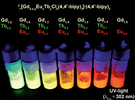 The molecular approach to materials is a fast growing field in modern science. Multifunctional molecular materials are both important to fundamental scientific interest and for potential applications. Especially, as a distinctive feature of molecular materials is either competition, coexistence, or cooperation of different physical and chemical properties.
The molecular approach to materials is a fast growing field in modern science. Multifunctional molecular materials are both important to fundamental scientific interest and for potential applications. Especially, as a distinctive feature of molecular materials is either competition, coexistence, or cooperation of different physical and chemical properties.The present project focuses on molecular materials that unite the key properties of magnetism and luminescence. This property combination is still an exception today as paramagnetism diminishes luminescence usually. However, a successful implementation of both properties in one compound allows for materials properties that emerge from the influence of magnetism on luminescence and vice versa. Thereby, the project has the aim to develop a novel sensing type benefitting from this property dependence. ...
02.06.2016
New collaborative research center in quantum physics
"OSCAR-Open System Control of Atomic and Photonic Matter" is a new transregional CRC associated with MAINZ. Within OSCAR, Kaiserslautern physicists, together with colleagues from the University of Bonn, will explore the new physics of open quantum systems in model systems such as atoms, ultra-cold quantum gases and photons.
OSCAR combines the collaborative efforts of theoretical and experimental groups with complementary expertise in few- and many-body physics, photonics and ultra-cold atom physics. OSCAR’s goal is to explore the novel physics of open systems, i.e. the physics resulting from time-dependent drive and coupling to tailored reservoirs across different experimental platforms. This comprises the generation of otherwise unreachable quantum states, their protection, and the control of dynamical and transport processes. The researchers aim to understand the underlying mechanisms of open systems and to exploit them as new tools for quantum control. To this end, they will also combine open-system control and topological protection.
The physical realizations of choice are atoms and photons for which the technology of manipulation and detection are most advanced and microscopic control and understanding of system and environment is possible. Open-system control is a versatile concept and the teams involved expect that the insights gained will open up new avenues for applications in technology and new device functionalities.
OSCAR will be funded by the Deutsche Forschungsgemeinschaft (DFG) with a total of 9.4 million euros and will start July 2016. In the first four-year funding period, the collaborative research center is coordinated by the University of Bonn. Hereafter, a transfer of the coordination to Kaiserslautern is planned. OSCAR is the fifth collaborative research center at the Kaiserslautern physics department. The center is embedded in the State Research Center "OPTIMAS" and was only made possible through this funding of the State Rhineland-Palatinate.
27.05.2016
Four MAINZ Alumni awarded at JGU’s Dies Academicus 2016
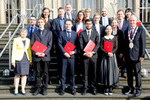 Dr. Christian Zerfaß AK Paulsen, Preis der Boehringer Ingelheim Stiftung, Dr. Bernd Oschmann AK Zentel, Preis der Boehringer Ingelheim Stiftung, Dr. Antonia Statt (AK Binder, Preis des Fachbereichs 08 - Physik, Mathematik und Informatik) and Dr. Sven Bach (AK Tremel, Forschungsförderpreis der Freunde der Universität Mainz e.V.) have been awarded at the JGU’s Dies Academicus 2016 ...
Dr. Christian Zerfaß AK Paulsen, Preis der Boehringer Ingelheim Stiftung, Dr. Bernd Oschmann AK Zentel, Preis der Boehringer Ingelheim Stiftung, Dr. Antonia Statt (AK Binder, Preis des Fachbereichs 08 - Physik, Mathematik und Informatik) and Dr. Sven Bach (AK Tremel, Forschungsförderpreis der Freunde der Universität Mainz e.V.) have been awarded at the JGU’s Dies Academicus 2016 ...06.05.2016
MAINZ Associated Member Jun.-Prof. Dr. Matteo Rizzi has been nominated "APS Outstanding Referee" by the American Physical Society
The Outstanding Referee program recognizes scientists who have been exceptionally helpful in assessing manuscripts. The referees’ efforts keep the standards of journals at a high level and help authors to improve the quality of their articles. ...
27.04.2016
MAINZ PhD students Hagen Söngen (AK Kühnle) and Sven Otto (AK Heinze) are among the new members of the Gutenberg Academy for Young Researchers.
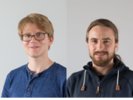 The academy brings together up to 25 of the JGU’s best PhD students and artists and provides them with the chance to participate in an interdisciplinary exchange of ideas at the highest intellectual level. ...
The academy brings together up to 25 of the JGU’s best PhD students and artists and provides them with the chance to participate in an interdisciplinary exchange of ideas at the highest intellectual level. ...13.04.2016
Excellence@WORK - Gutenberg Alumni Talks in Natural Sciences: new lunch talk series supported by GNK
Excellence@WORK offers personal insights into a broad range of scientists‘ careers. It illustrates job perspectives for young scientists relying on Gutenberg Alumni as role models and trustful advisors.
Alumnae and alumni report on
- individual careers in IT, manufacturing, microelectronic, pharmaceutical and chemical industry, consulting, NGOs or public institutions
-
area of operations, career paths, success factors, helpful personal competences and skills, job perspectives and the relevance of their studies and doctoral education
We thus take advantage of the JGU alumni network for (doctoral) students from natural sciences at JGU, IMB, MPI-C and MPI-P. Students gain personal insights into daily routine and career paths of alumni and profit for their personal career planning.
Please note that these talks will be conducted in German. ...
05.04.2016
European Research Council (ERC) Advanced Grant for MAINZ PI Burkard Hillebrands: Supercurrents with magnons - the basis for future data processing technologies
The Grant of the European Research Council (ERC) for the Physicist from the University of Kaiserslautern is endowed with more than 2.4 million euros.
With the ERC funding Hillebrands will open up a new field of research: supermagnonics. He and his team will investigate macroscopic magnonic quantum phenomena with the aim to make data processing significantly more efficient. The award-winning concept is an advancement of magnonics – a field which was already fundamentally co-developed by Hillebrands. It is based on magnetic phenomena in crystal lattices that are caused by the spin, or intrinsic angular momentum, of electrons. Immaterial spin waves (known as magnons) serve as a medium and carrier of information. As waves are able to transmit more information than electrons and heat generation can be kept to a minimum, this creates completely new means of making data processing substantially more efficient. One day this may lead to new systems of computer technology.
Quantum phenomena on a macroscopic scale
With his supermagnonic research, Professor Hillebrands seeks to take the field of magnonics a critical step forwards. “We want to study phenomena that are analogous to superconductivity with electrons or to superfluidity in super-cooled liquid helium, i.e. phenomena which have macroscopic dimensions,” the researcher explains. “Quantum effects are usually only observed at an atomic or subatomic scale.”
In previous experiments he and his team have already demonstrated that magnons can form what is known as a Bose-Einstein condensate (BEC). This is a special type of matter which is characterised by the fact that all the particles (in this case magnons) adopt an identical, precisely defined basic state. By manipulating this condensate accordingly, it is possible to trigger magnonic supercurrents that flow without any loss of energy – these can be applied for information processing.
Over the next five years, Burkard Hillebrands intends to use the ERC grant to explore the basic mechanisms behind supermagnonics. In doing so, he will benefit from his many years of experience as a pioneer of magnonics. “In my team that belongs to the State Research Center OPTIMAS, we have developed the diagnostic tool of Brillouin spectroscopy over the course of many years. This is now proving to be invaluable to us”, emphasizes the experimental physicist. “In simple terms, it enables us to analyze the magnonic processes within the magnetic crystal films by way of scattering laser light.” The research planned by Hillebrands is complemented ideally by the ERC Starting Grant recently awarded to his co-worker Dr Andrii Chumak for advancing the technological aspects of magnonics.
Excellent research achievement
Every year the European Research Council awards funding in the form of the ‘ERC Advanced Grant’ amounting to up to 2.5 million euros per research project to established scientists who are leading in the respective field of research. It is hence the European Union’s most important scientific prize. It is granted to internationally recognized top researchers who have gained attention for their outstanding achievements and ground-breaking project ideas. The fact that one of these awards has now been conferred to Professor Hillebrands shows the increasing significance of the field of magnonics. “We do not just see the award as a personal accolade,” the researcher notes, “but also as motivation for the whole team who will carry on the successful research with huge determination.”
The first aim will be the development of robust laboratory methods that can be used to create magnonic supercurrents in BECs. A key aspect of this is to learn how these supercurrents can be controlled by electrical fields. “This is absolutely pioneering work,” the physicist points out, “here we are working with high risks, but the gains also stand to be huge. This may even mean that our research findings might open up completely different and unexpected opportunities.” ...
08.03.2016
PhD Award of the German Physical Society to MAINZ-Alumnus Fabian Grusdt
During the recent Spring Meeting of the German Physical Society (Deutsche Physikalische Gesellschaft, DPG) – Section Atoms, Molecules, Quantum optics and Plasmas (SAMOP), Fabian Grusdt (now Harvard) was awarded the PhD Prize 2016. In a final round of scientific oral presentations Fabian Grusdt achieved the Award amongst three competitors. The Award renders him to „Germany’s best Ph.D. Student” of the AMOP section the second largest section of DPG. Fabian Grusdt did his Ph.D. in the group of Michael Fleischhauer (Department of Physics, TU Kaiserslautern) and finished it last year at the young age of 24. In the meantime he is a postoc at Harvard University, again in a very prestigious framework – he was awarded a fellowship of the Moore Foundation that provides him with a 3-year independent research stay.
In his Ph.D. thesis „Topological phases and polaron physics in ultracold quantum gases“ Fabian Grusdt has made important contributions to two research topics of very high interest in many body physics and quantum optics – systems of topological order and the physics of Bose polarons. For the first time, he provided a generalization of the bulk-boundary correspondence principle that is crucial for topological systems to interacting bosons.
Moreover, he has developed new detection methods for Z2 topological invariants and topological invariants of interacting systems. An important part of his dissertation focussed on one of the oldest but still not fully understood problems in condensed matter: Bose polarons.
For this, Fabian Grusdt developed a completely new theoretical approach based on the renormalization group which has lead to first semi-analytical theory of Fröhlich polarons in the whole range of interaction strengths. The community considers his all-coupling theory of Fröhlich polarons as a very important finding.
04.03.2016
Excellent teaching builds on excellent research: MAINZ PI Artur Widera receives Teaching Award
The Rhineland-Palatinate teaching award of the Ministry of Education, Science, and Culture (MBWWK) was recently awarded to MAINZ faculty member Artur Widera of the University of Kaiserslautern. This award is part of the higher education program "Wissen schafft Zukunft" (science for future) and is given within ten academic disciplines. Each award is endowed with 10.000 €
"I am very glad about this award, because teaching is really on my heart. For me, good teaching comes from good research and I really enjoy to develop new methods and applications with my students in order to better introduce them to the subject" explains Artur Widera. In 2010, Widera came to the University of Kaiserslautern from the University of Bonn. He does research and teaching in quantum physics in ultracold matter in order to understand quantum phenomena at single atoms at temperatures below that in space. For Widera this is not the first award. In 2013 he was awarded the University Teaching Award for the use of voting tools in teaching. In 2011, he received an ERC Starting Grant, the most prestigious European Research Award.
02.03.2016
International research team achieves controlled movement of skyrmions
A joint research project being undertaken by Johannes Gutenberg University Mainz (JGU) and the Massachusetts Institute of Technology (MIT) has achieved a breakthrough in fundamental research in the field of potential future data storage technologies. The idea is that electronic storage units (bits) will not be stored on rotating hard disks as is currently standard practice but on a nanowire in the form of magnetic vortex structures—so-called skyrmions—, using a process similar to that of a shift register. The magnetic skyrmion bits would be rapidly accessible, while storage density would be high and there would be improved energy efficiency. The project team managed, for the first time, to achieve targeted shifting of individual skyrmions at room temperature using electrical impulses. Their results have been published in the journal Nature Materials.
Magnetic skyrmions are special spin configurations that can occur in materials and particularly in thin layer structures when the inversion symmetry is broken. With regard to the systems that are of interest here, this means that a thin metal film with a non-symmetrical layer structure can be employed. In materials such as this, spin configurations that behave rather like a hair whorl can form. It can be just as difficult to eradicate a skyrmion as it can be to smooth out a hair whorl, a property that gives skyrmions enhanced stability.
An important characteristic of skyrmions is that they can exist in isolation in magnetic materials and generally do not tend to collide with the edge of a structure. This provides them with the unique ability to skirt any isolated defects or unevenness in the material with which other magnetic structures, such as domain walls, would collide. Skyrmions are therefore excellent candidates for use with magnetic shift registers, otherwise known as racetrack memory. Information could be encoded in the form of skyrmions and an electrical current could be employed to move them past fixed read/write heads. The process would be both rapid and completely independent of movable mechanical components and thus ideally suited for mobile applications.
During the project, it was demonstrated that individual skyrmions can indeed be moved in a controlled manner along a magnetic wire, i.e., the so-called racetrack, by exposing them to brief electrical impulses at room temperature. In addition, new methods to describe their dynamics were developed and confirmed by experimentation. This work can thus be regarded as laying down the cornerstone for the future use of skyrmions in application-related systems.
"It is always great to see when a joint project quickly leads to exciting results. This is particularly true in this case, as we have been able to produce this journal article within just a year of entering into our cooperation agreement. It would never have come about had it not been for the close collaboration between Mainz University and MIT and the lively exchange of ideas," said Kai Litzius, co-author of the article. Litzius is on a stipendiary scholarship awarded by the Graduate School of Excellence "Materials Science in Mainz" (MAINZ) and is a member of the team headed by Professor Mathias Kläui.
"I'm delighted by the way we were able to work efficiently and continuously with groups at MIT. After receiving start-up funding through a joint project financed by the German Federal Ministry of Education and Research, we have been able to produce six joint publications since 2014, partly as the result of several student visits to MIT," emphasized Kläui, a professor at the Institute of Physics and the director of the MAINZ Graduate School of Excellence.
Establishment of the MAINZ Graduate School was approved through the Excellence Initiative by the German Federal and State Governments to Promote Science and Research at German Universities in 2007 and its funding was extended in the second round in 2012. It consists of work groups from Johannes Gutenberg University Mainz, TU Kaiserslautern, and the Max Planck Institute for Polymer Research in Mainz. One of its focal research areas is spintronics, where cooperation with leading international partners plays an important role.
___________________________________________________________________________
Seonghoon Woo et al.
Observation of room-temperature magnetic skyrmions and their current-driven dynamics in ultrathin metallic ferromagnets
Nature Materials, 29 February 2016
DOI: 10.1038/nmat4593 ...
10.02.2016
Spin waves out of waste heat: Researchers present new findings on magnetic spin waves
Spin waves, or magnons, are fundamental excitations in magnetic materials which transport energy and angular momentum. The latter allows to make use of them for the transmission of information within magnetic solids. Since their existence is bound to that of magnetic solids, they are challenging to measure. This circumstance led to quite a number of difficulties with respect to the proof of fundamental theories about the properties of magnetic materials. In a joined project, the researchers involved were able to show that even in complex systems consisting of many different magnetic atoms, magnons can be thermally excited by making use of the recently understood spin Seebeck effect. These results furthermore show that the spin Seebeck effect can be employed to probe fundamental properties of such systems in a simple way and thus to deduce the complex interplay of the constituents.
The spin Seebeck effect represents a so-called spin-thermoelectric effect, which enables the conversion of thermal energy into electrical energy. Contrary to conventional thermoelectric effects, it also enables the recovery of heat energy in magnetic insulators in combination with a thin metallic layer. Researchers at Mainz University have recently been able to demonstrate that the origin of the spin Seebeck effect can be understood as thermally excited spin waves within the magnetic solid. These thermal spin waves present a so far unexploited way for the energy recovery of waste heat.
Following this discovery, the researchers started investigations of more complex materials, so called ferrimagnets. In contrast to simple ferromagnetic materials, ferrimagnets possess a non-trivial temperature dependence of the magnetization, resulting of a complex interplay of its different magnetic sublattices. By making use of temperature dependent spin Seebeck measurements of ferrimagnetic materials, it was possible to deduce characteristic and thus unique signal features. These features can be traced back to the magnonic origin of the effect and therefore allow to gain a new idea of thermal magnons and their distribution.
____________________________________________________________________________
Stephan Geprägs, A. Kehlberger, F. Della Colleta, et al.
Nature Communications 7, Article number: 10452, Published 04 February 2016
DOI:10.1038/ncomms10452 ...
27.01.2016
Klaus Müllen becomes a new Gutenberg Research Fellow
In recognition of his scientific achievements, Professor Dr. Klaus Müllen, emeritus director at the Max-Planck Institute for Polymer Research in Mainz, Germany, has been appointed by the President of the Johannes Gutenberg University (JGU) as a Gutenberg Research Fellow for a period of three years. The ceremony will take place in the “Hochschule für Musik” on May 2 during the Gutenberg Research College (GRC) annual ceremony.
The GRC fellowship assures each fellow first class research conditions. It is generously endowed. Funds for academic personnel as well as for material expenses are available. The GRC fellows are expected to offer their expertise to young academics – for example with Research Training Groups or the Gutenberg Academy. In the long term, the fellows contribute to the elaboration of perspectives and strategies concerning the future development of the Johannes Gutenberg University.
The GRC, established in 2007, serves as a central strategic instrument to promote cutting-edge research at JGU. The GRC runs an annual budget of €2 million, provided in equal parts by the State and by JGU. ...
20.01.2016
MAINZ Associated Member Dr. Frederik Wurm nominated for the Reimund Stadler prize
Dr. Frederik Wurm was nominated on September 29 for his research and the associated talk he gave on "Poly(phosphoester)s: from adhesives to polymer therapeutics". He will be awarded the Reimund Stadler prize - endowed with € 5,000 - in Halle in the autumn 2016. Exceptionally this year, during the postdoctoral workshop of the GDCh division of Macromolecular Chemistry held at the Lanxess production site, in Leverkusen the jury selected two winners. ...
13.01.2016
MAINZ PhD Christoph Kreitner (group of Prof. Heinze) publishes a cover article in the journal Inorganic Chemistry 2015
In the publication „Understanding the Excited State Behavior of Cyclometalated Bis(tridentate)ruthenium(II) Complexes: A Combined Experimental and Theoretical Study”, published in Inorganic Chemistry in 2015, Christoph Kreitner of the group of Katja Heinze tackles two fundamental questions concerning a promising class of bis(tridentate)ruthenium(II) complexes incorporating a cyclometalating N^C^N and a terpyridine N^N^N ligand.
First, in contrast to common belief in the literature, they demonstrated by Resonance Raman Spectroscopy and density functional calculations that both ligands contribute to the prominent visible range absorption features. Second, the unexpected poor emission quantum yields of these complexes is traced back to a previously unrecognized dark LL’CT state which provides a parasitic pathway for the deactivation of the emissive excited state. The importance of these results was highlighted as a cover article in the December issue of Inorganic Chemistry. ...
12.01.2016
Prof. Katharina Landfester has become a member of the Board of the German Chemical Society
 Katharina Landfester, Director at the Max Planck Institute for Polymer Research and head of the Physical Chemistry of Polymers department, was appointed member of the Board of the German Chemical Society GDCh on January 1, 2016. She will serve for the next four years until 2019. The Board of the GDCh is made up of scientists who have excelled in their performance across the spectrum of all branches of chemistry. It is composed of 15 members, seven of whom are scientists from universities, research institutes or government departments, while another seven are from industry or are independent consultants. The fifteenth Board member is the chair of one of the GDCh divisions delegated for a two-year term. With some 31,000 members, the GDCh is one of the largest chemical societies worldwide. ...
Katharina Landfester, Director at the Max Planck Institute for Polymer Research and head of the Physical Chemistry of Polymers department, was appointed member of the Board of the German Chemical Society GDCh on January 1, 2016. She will serve for the next four years until 2019. The Board of the GDCh is made up of scientists who have excelled in their performance across the spectrum of all branches of chemistry. It is composed of 15 members, seven of whom are scientists from universities, research institutes or government departments, while another seven are from industry or are independent consultants. The fifteenth Board member is the chair of one of the GDCh divisions delegated for a two-year term. With some 31,000 members, the GDCh is one of the largest chemical societies worldwide. ...20.11.2015
New Collaborative Research Center for Spin Phenomena
 The DFG has approved funding for the SFB/Transregio 173 "SPIN+X: Spin in its collective environment.“ This initiative combines physics, chemistry and engineering sciences in Kaiserslautern and Mainz. It will be funded with 12 Million Euro. ...
The DFG has approved funding for the SFB/Transregio 173 "SPIN+X: Spin in its collective environment.“ This initiative combines physics, chemistry and engineering sciences in Kaiserslautern and Mainz. It will be funded with 12 Million Euro. ...28.10.2015
A team of researchers including MAINZ PhD Hannah Pohlit developed a more easily tolerable method for the treatment of allergies
Allergen-specific immunotherapy (SIT) is the only available cause-oriented therapy for allergies so far. In their publication the authors introduce a method to encapsulate allergens into nanoparticles to avoid severe side effects during SIT.
DOI: 10.1021/acs.biomac.5b00458 ...
13.10.2015
MAINZ Award 2014 granted to Dr. Markus Bannwarth and Dr. Isabel Schick
Every year the MAINZ Award is granted for two outstanding PhD theses. Former PhD students who achieve a degree "with distinction" (summa cum laude) and manage to complete the MAINZ certifivate are candidates for nomination by their supervisors.
The recipients of the MAINZ Award 2014 are Dr. Markus Bannwarth (right) and Dr. Isabel Schick (left). ...
13.10.2015
MAINZ Graduate School of Excellence awards Visiting Professorships 2015
Oxford theoretical physicist Dieter Jaksch and spintronics expert Thierry Valet have been awarded MAINZ Visiting Professorships
The Graduate School of Excellence "Materials Science in Mainz" (MAINZ) has awarded the 2015 MAINZ Visiting Professorships to two European researchers. The Visiting Professorships went to Professor Dieter Jaksch (on the left) of the University of Oxford, England, and Thierry Valet (on the right) from France. Visiting Professorships are used to attract foreign scientists to the various departments of the MAINZ Graduate School so that they undertake part of their research here and on this occasion work with the doctoral candidates studying at MAINZ. The Visiting Professorships have been awarded to up to two winners each year since 2013. The award winners are invited to spend up to twelve months working at MAINZ during a two year period. Their input can take the form of lectures, workshops, or other contributions which help the training of doctoral candidates. They thus provide important new educational stimuli and in turn help establish a relationship between MAINZ and their home universities. ...
02.10.2015
MAINZ PhD Student Hannah Pohlit is one of the two very first awardees of the ALK "Förderpreis Allergologie"
This year, the pharmaceutical company ALK-Abelló donated for the first time, in cooperation with the German association for allergology and clinical immunology (GDGAKI), the association for pediatric allergology and environmental medicine (GPA) and the association of German allergists (AeDA), a development award for allergology. The prize, endowed with 30.000 EUR, has been awarded to Hannah Pohlit, JGU Mainz, and Georg Bölke, Charité Berlin.
(Picture: © Anke Sinnigen, ALK-Abelló) ...
06.10.2015
MAINZ PhD Student Moritz Barkowski wins second prize in the poster session of the CECAM Workshop in Lausanne
MAINZ PhD student Moritz Barkowski won the second prize in the poster session with the title "Depth-dependent study of femtosecond spin-currents in Ni/Au" of the CECAM Workshop "Exploration of ultra-fast timescales using time dependent density functional theory and quantum optimal control theory in Lausanne, Switzerland.
______________________________________________________________________________
M. Barkowski, O. Schmitt, J. Urbancic, S. Eich, J. Mao, S. Sadashivaiah,
D. Steil, M. Cinchetti, S. Mathias, and M. Aeschlimann
06.10.2015
Publication by MAINZ PhD Students Sven Otto and Christoph Kreitner highlighted as Hot Paper in Angewandte Chemie
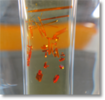 The publication, which is part of the Angewandte Chemie Special Issue “International Year of Light” reports the extraordinary near infrared emission behavior of the chromium(III) complex [Cr(ddpd)2]3+. It outperforms every known 3d metal complex with the emission quantum yield (12 % in water) being at least an order of magnitude higher than that of every known first row transition metal complex. These efficiencies are usually only achieved by precious or rare earth metals like platinum or europium.
The publication, which is part of the Angewandte Chemie Special Issue “International Year of Light” reports the extraordinary near infrared emission behavior of the chromium(III) complex [Cr(ddpd)2]3+. It outperforms every known 3d metal complex with the emission quantum yield (12 % in water) being at least an order of magnitude higher than that of every known first row transition metal complex. These efficiencies are usually only achieved by precious or rare earth metals like platinum or europium.
Intelligent ligand design, increasing the ligand field splitting beyond the usual regime for chromium(III) complexes made these outstanding properties possible. Such large ligand field splitting for chromium(III) is otherwise only known from the solid material ruby, where it is used in the important solid state ruby laser. The molecular complex further exhibits superior stability in solution over a long time and under irradiation as well and does not oxidatively damage biological material under irradiation. These properties, together with the simple synthesis, make [Cr(ddpd)2]3+ very promising as an inexpensive alternative to currently employed materials based on rare earth metals for biological applications like in vivo oxygen sensing.
______________________________________________________________________________
S. Otto, M. Grabolle, C. Förster, C. Kreitner, U. Resch-Genger*, K. Heinze*, Angew. Chem. 2015, 127, 11735–11739; Angew. Chem. Int. Ed. 2015, 54, 11572-11576
[DOI: 10.1002/anie.201504894] [DOI: 10.1002/ange.201504894] ...
21.09.2015
MAINZ at “Wissenschaftsmarkt 2015”
MAINZ has participated at the “Wissenschaftsmarkt 2015” with interesting and sometimes amazing applications from the world of materials. Experiments and exponents from Chemistry, Optics, and Quantum Physics have been presented: Secure explosives samples for search dogs; Who can smell better?; Optical light fibers to touch; Playing with interference of light; Laser Spectroscopy: understanding and controlling atoms; and ‘A refrigerator by light for temperatures close to absolute zero - matter on the way in the quantum world’ by research groups from Mainz (Prof. Waldvogel lab) and Kaiserslautern (Profs. Ott and Widera labs). This public-science-dialog had plenty of opportunities. For the visitor to observe live experiments and ask questions; and for the scientists to listen, reflect and gather impulses, making it an interesting, informative, fun event for all.
(Picture: © Barbara Walzer)
15.09.2015
Greenhorn Meeting 2015
The recent “Greenhorn Meeting” at the Department of Physics of the University of Kaiserslautern brought together young researchers from quantum optics, atom optics and experimental quantum physics. The participants, bachelor and master students, as well as PhD students, came from all over Germany, Denmark and Austria. They presented their research projects in posters and lectures und discussed about them in a casual atmosphere. Kaiserslautern made favorable impressions on all guests not only for its own research in the area of quantum optics but also for the attractive social program. An excursion to Hambach Castle and the conference dinner at a traditional Kaiserslautern restaurant, including new wine, was very well received. The conference was organized by MAINZ PhD student Felix Schmidt and his colleague Tobias Lausch from the research group of Professor Artur Widera.
Financial support was provided by the State Research center OPTIMAS, by MAINZ and by the collaborative research program SFB/TRR 49. Also several laser companies made generous financial contributions. ...
08.09.2015
Indications of the origin of the Spin Seebeck effect discovered
Thermally excited magnetic waves enable generation of electricity using insulators
The recovery of waste heat in all kinds of processes poses one of the main challenges of our time to making established processes more energy-efficient and thus more environmentally friendly. The Spin Seebeck effect (SSE) is a novel, only rudimentarily understood effect, which allows for the conversion of a heat flux into electrical energy, even in electrically non-conducting materials. A team of physicists at Johannes Gutenberg University Mainz (JGU), the University of Konstanz, the University of Kaiserslautern, and the Massachusetts Institute of Technology (MIT) have now succeeded in identifying the origin of the Spin Seebeck effect. By the specific investigation of the material- and temperature-dependence of the effect, the German and American researchers were able to show that it exhibits a characteristic length scale attributable to its magnetic origin. This finding now allows for the advancement of this long-time controversial effect in terms of first applications. The resulting research paper was published in the scientific journal Physical Review Letters, with a fellow of the JGU-based Graduate School of Excellence "Materials Science in Mainz" (MAINZ) as first author.
The Spin Seebeck effect represents a so-called spin-thermoelectric effect, which enables the conversion of thermal energy into electrical energy. Contrary to conventional thermoelectric effects it also enables the recovery of heat energy in magnetic insulators in combination with a thin metallic layer. Owing to this characteristic, it was assumed that the effect originates from thermally excited magnetic waves. The currently employed method of measurement, which makes use of a second metallic layer converting these magnetic waves into a measurable electrical signal, has so far not been able to allow for a distinct assignment of experimentally detected signals.
By measuring the effect for different material thicknesses in the range of a few nanometers up to several micrometers as well as for different temperatures, the scientists have found characteristic behavior. In thin films the signal amplitude increases with increasing material thickness and eventually saturates after exceeding a sufficient thickness. In combination with the detected enhancement of this critical thickness at low temperatures, the agreement with the theoretical model of thermally excited magnetic waves developed at Konstanz could be demonstrated. With these results, the researchers were able for the first time to reveal a direct relation between the assumed thermally excited magnetic waves and the effect.
"This result provides us with an important building block of the puzzle of the comprehension of this new, complex effect, unambiguously demonstrating its existence," said Andreas Kehlberger, Ph.D. student at Johannes Gutenberg University Mainz and first author of the publication.
"I am very pleased that this exciting result emerged in a cooperation of a doctoral candidate out of my group at the Graduate School of Excellence 'Materials Science in Mainz' together with co-workers from Kaiserslautern and our colleagues from Konstanz, with whom we collaborate within the Priority Program 'Spin Caloric Transport' funded by the German Research Foundation (DFG)," emphasized Professor Mathias Kläui, director of the MAINZ Graduate School of Excellence based at Mainz University. "It shows that complex research is only possible in teams, for instance with funding by the German Federal Ministry of Education and Research (BMBF) through the Mainz-MIT Seed Fund."
____________________________________________________________________________
Kehlberger, A. et al.
Length Scale of the Spin Seebeck Effect
Physical Review Letters, 28. August 2015
DOI: 10.1103/PhysRevLett.115.096602 ...
24.08.2015
Poster awards to MAINZ Ph.D. student Dmytro Bozhko
Together with his co-authors, 2nd year Ph.D. student Dmytro Bozhko from TU Kaiserslautern was awarded these two prestigious poster awards recently:
- Gold Poster Award at the 8th IEEE Magnetics Society Summer School 2015 (Minneapolis, USA, June 14-19, 2015) for poster "Spin pumping by Bose-Einstein condensate of magnons in YIG/Pt bilayers" by D.A. Bozhko, A. Kirihara, Y. Tserkovnyak, A.V. Chumak, B. Hillebrands and A.A. Serga, presented.
- Best Poster Award of Monday's Session of the 20th International conference on Magnetism (ICM 2015; Barcelona, July 5-10, 2015) for poster "Stimulated thermalization of a parametrically driven magnon gas as a prerequisite for Bose-Einstein magnon condensation" by D.A. Bozhko, P. Clausen, V.I. Vasyuchka, B. Hillebrands, G.A. Melkov, and A.A. Serga.
12.08.2015
Carl Zeiss Foundation donates EUR 850,000 to the Advanced Lab for Electrochemistry and Electroorganic Synthesis at Mainz University
Research structure concept of ELYSION enhances the strategic relevance of Mainz in the fields of electroconversion and electroactive materials
Over the next four years, the Carl Zeiss Foundation will be providing support in the form of EUR 850,000 to the Advanced Lab for Electrochemistry and Electroorganic Synthesis (ELYSION), a unique collaborative research concept based at the Institute of Organic Chemistry and the Institute of Inorganic Chemistry and Analytical Chemistry at Johannes Gutenberg University Mainz (JGU). The use of electricity as a catalyst in chemical reactions is one of the most sustainable methods of synthesizing materials and chemical compounds. The accompanying development of electrolytic conversion techniques and new types of electrodes will make it possible to overcome the existing frontiers of this future-oriented approach. ...
12.08.2015
Ana Fokina has been awarded a Journal of Materials Chemistry C runner up Poster Prize
 MAINZ PhD Ana Fokina won the prize at the 12th International Symposium on Functional p-Electron Systems Fp-12, University of Washington, Seattle USA, 19th-24th July 2015 ...
MAINZ PhD Ana Fokina won the prize at the 12th International Symposium on Functional p-Electron Systems Fp-12, University of Washington, Seattle USA, 19th-24th July 2015 ...07.08.2015
Article on "Thermodynmaic picture of ultrafast charge transport in graphene", co-authored by the MAINZ Faculty members Prof. Müllen, Prof. Bonn and Prof. Turchinovich, published in Nature Communications
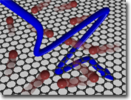 The team of scientists at the Max Planck Institute for Polymer Research MPI-P discovered that electrical conduction in graphene on the picosecond timescale – a picosecond being one thousandth of one billionth of a second – is governed by the same basic laws that describe the thermal properties of gases. This much simpler thermodynamic approach to the electrical conduction in graphene will allow scientists and engineers not only to better understand but also to improve the performance of graphene-based nanoelectronic devices. ...
The team of scientists at the Max Planck Institute for Polymer Research MPI-P discovered that electrical conduction in graphene on the picosecond timescale – a picosecond being one thousandth of one billionth of a second – is governed by the same basic laws that describe the thermal properties of gases. This much simpler thermodynamic approach to the electrical conduction in graphene will allow scientists and engineers not only to better understand but also to improve the performance of graphene-based nanoelectronic devices. ...31.07.2015
Greta Becker won the Poster Award at the IP'15- International Symposium on Ionic Polymerization on July 05-10, 2015
 The title of her poster was "Polyphosphoesters as shielding polymers: Investigations on the stealth effect of PPEylated nanocarriers". ...
The title of her poster was "Polyphosphoesters as shielding polymers: Investigations on the stealth effect of PPEylated nanocarriers". ...16.07.2015
Prof. Klaus Müllen – the most cited German scientist in chemistry – is awarded a new honorary degree
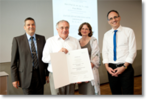 Professor Klaus Müllen, Director at the Max Planck Institute for Polymer Research MPI-P and MAINZ PI, was awarded an honorary doctorate by the Faculty of Science of the Ulm University. ...
Professor Klaus Müllen, Director at the Max Planck Institute for Polymer Research MPI-P and MAINZ PI, was awarded an honorary doctorate by the Faculty of Science of the Ulm University. ...07.07.2015
Publications Highlight in Nature Physics, Giant magnetoresistance systems examined by means of ultrafast terahertz spectroscopy
 The forward-looking technology of spintronics now has a new, highly effective investigative instrument: German physicists from Mainz and Berlin have successfully employed ultrafast terahertz spectroscopy to determine the basic properties of spintronics components. In a joint project involving our research group and the group of Dmitry Turchinovich at the Max Planck Institute for Polymer Research in Mainz MPI-P and also the Mainz-based Sensitec GmbH and the Fritz Haber Institute of the Max Planck Society in Berlin, the collaborating teams were able to directly observe with ultrafast terahertz spectroscopy the magnetotransport in a ferromagnetic structure and then precisely and distinctly measure the relevant parameters, i.e., the spin-dependent charge-carrier densities and the spin-related scattering times of the conducting electrons. ...
The forward-looking technology of spintronics now has a new, highly effective investigative instrument: German physicists from Mainz and Berlin have successfully employed ultrafast terahertz spectroscopy to determine the basic properties of spintronics components. In a joint project involving our research group and the group of Dmitry Turchinovich at the Max Planck Institute for Polymer Research in Mainz MPI-P and also the Mainz-based Sensitec GmbH and the Fritz Haber Institute of the Max Planck Society in Berlin, the collaborating teams were able to directly observe with ultrafast terahertz spectroscopy the magnetotransport in a ferromagnetic structure and then precisely and distinctly measure the relevant parameters, i.e., the spin-dependent charge-carrier densities and the spin-related scattering times of the conducting electrons. ...25.06.2015
Three MAINZ Alumni awarded at JGU’s Dies Academicus 2015
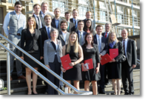 Adrian Natalello AK Frey, Preis der Boehringer Ingelheim Stiftung, Christian Plenk AK Rentschler, Forschungsförderpreis der Freunde der Universität Mainz and Jeanette Hilf (AK Frey, Preis der JGU, FB 09) have been awarded at the JGU’s Dies Academicus 2015. ...
Adrian Natalello AK Frey, Preis der Boehringer Ingelheim Stiftung, Christian Plenk AK Rentschler, Forschungsförderpreis der Freunde der Universität Mainz and Jeanette Hilf (AK Frey, Preis der JGU, FB 09) have been awarded at the JGU’s Dies Academicus 2015. ...28.05.2015
TRR 49 funding extended
 The Senate Committee for the Collaborative Research Centres of the DFG has granted the continuation of the Transregional Collaborative Research Centre “Condensed Matter Systems with variable Many-Body Interactions“ TRR49 in which several MAINZ PIs at TU Kaiserslautern and JGU participate. The Centre was established in 2007 at the TU Kaiserslautern, the JGU and the Goethe-Universität Frankfurt and will be funded for four more years. Likewise, the Collaborative Research Centre "Component Surfaces" SFB 926 which was established in 2011 at TU Kaiserslautern will also be funded for four more years. ...
The Senate Committee for the Collaborative Research Centres of the DFG has granted the continuation of the Transregional Collaborative Research Centre “Condensed Matter Systems with variable Many-Body Interactions“ TRR49 in which several MAINZ PIs at TU Kaiserslautern and JGU participate. The Centre was established in 2007 at the TU Kaiserslautern, the JGU and the Goethe-Universität Frankfurt and will be funded for four more years. Likewise, the Collaborative Research Centre "Component Surfaces" SFB 926 which was established in 2011 at TU Kaiserslautern will also be funded for four more years. ...13.05.2015
Hai Wang Receives Prestigious Chinese Government Award for Outstanding Self-Financed Students Abroad
Hai Wang, a PhD student in the department of Molecular Spectroscopy at MPIP has been awarded with the "2014/15 Chinese Government Award for Outstanding Self-Financed Students Abroad". This prestigious prize, sponsored by the Chinese Ministry of Education, recognizes the academic excellence of self-financed Chinese students studying overseas, being granted yearly across all research disciplines among more than 30000 students in Germany. Hai Wang received the prize from the Chinese ambassador, Mr. Shi Mingde, in a ceremony that was held in Berlin on 9th of May, 2015.
Since January 2012, Hai is a student within the "Graduate School of Excellence – Materials Science in Mainz” at the Johannes Gutenberg University in Mainz. Together with Dr. Enrique Canovas and Prof. dr. Mischa Bonn, Hai's work have been devoted to the characterization and modelling of photo-induced electron transfer processes at hybrid interfaces, which are relevant for novel low cost energy conversion schemes (solar cells and fuels). Hai has demonstrated the tunneling nature of bridge mediated charge transfer in quantum dot sensitized architectures1; the suitability of atomic passivation of QDs by fine tuning of surface chemistry by stoichiometry control2; and, in collaboration with partners at University Jaume I (Spain) and East China University of Science and Technology (China) Hai contributed to the development of world-record efficiency quantum dot sensitized solar cells3. At present Hai is working on increasing the efficiency of electron transfer processes in photovoltaic building blocks; these works could pave the way towards solar cells with efficiencies exceeding the Shockley-Queisser limit (efficiencies beyond 30%).
Reference
1 Wang, H. et al. Tuning electron transfer rates through molecular bridges in quantum dot sensitized oxides. Nano Lett. 2013, 13, 5311−5315.
2 Wang, H. et al. Interplay between structure, stoichiometry, and electron transfer dynamics in SILAR-based quantum dot-sensitized oxide. Nano Lett. 2014, 14, 5780−5786.
3 Zhao, K. et al. Boosting Power Conversion Efficiencies of Quantum-Dot-Sensitized Solar Cells Beyond 8% by Recombination Control. J. Am. Chem. Soc. 2015, 137, 5602–5609.
30.04.2015
New high-level functions for MAINZ PI Prof. Dr. Martin Aeschlimann
At the spring meeting of the German Physical Society (DPG), Prof. Dr. Martin Aeschlimann (MAINZ PI at TU Kaiserslautern) has been elected as speaker of the Society’s Condensed Matter Section (SKM). This section is the largest of the three sections of the DPG which in turn is the world's largest physical society. The section which Aeschlimann now heads for three years represents more than 18,000 members in 13 divisions. The scientific scope ranges from biological and chemical physics to surface physics and magnetism as well as physics of low temperatures. The SKM speaker is the scientific director of the spring meeting, which brings together far more than 6,000 participants every year. Next to the corresponding meeting of the American Physical Society (APS) it is the largest physics conference in the world.
Also at the DPG spring meeting Prof. Dr. Burkard Hillebrands (MAINZ PI at TU Kaiserslautern) was elected as speaker of the Magnetism Work Group. This work group is a joint committee of the DPG (Division on Magnetism), the German Society of Material Science (DGM), the VDE Scientific Association of Electrical Engineering, Electronic Information Technology Association, Energy-Technology Society (ETG in the VDE) and the German Association of Iron and Steel Research (VDEh). The Magnetism Work Group promotes scientific research and technical applications of magnetism in Germany, as well as in the European and global context. Lectures and discussion meetings are organized, and with the ThyssenKrupp Electrical Steel Dissertation Prize the promotion of young researchers is targeted.
27.04.2015
2 MAINZ members admitted to the Gutenberg Academy
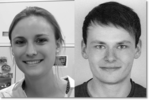 MAINZ PhD students Jana Herzberger AK Frey and Sven Bach AK Tremel are among the new members of the Gutenberg Academy for Young Researchers. They were admitted to the academy in a ceremony on April 27 together with nine other PhD students, joining amongst others MAINZ PhD students Stephan Köhler, Hannah Köhring, Christoph Kreitner and Daniel Rost. The academy brings together up to 25 of the Johannes Gutenberg University’s best PhD students and artists and provides them with the chance to participate in an interdisciplinary exchange of ideas at the highest intellectual level. ...
MAINZ PhD students Jana Herzberger AK Frey and Sven Bach AK Tremel are among the new members of the Gutenberg Academy for Young Researchers. They were admitted to the academy in a ceremony on April 27 together with nine other PhD students, joining amongst others MAINZ PhD students Stephan Köhler, Hannah Köhring, Christoph Kreitner and Daniel Rost. The academy brings together up to 25 of the Johannes Gutenberg University’s best PhD students and artists and provides them with the chance to participate in an interdisciplinary exchange of ideas at the highest intellectual level. ...22.04.2015
SPICE officially opened
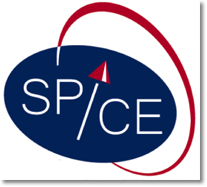 On April 22, the Spin Phenomena Interdisciplinary Center SPICE headed by MAINZ PI Jairo Sinova was officially opened at Johannes Gutenberg University Mainz. The center will facilitate interactions between the many diverse fields that study spin-related phenomena – at a level that each field could not achieve on its own. SPICE is sponsored by the Alexander von Humboldt Foundation with a Humboldt Professorship for Jairo Sinova and the German federal state of Rhineland-Palatinate. ...
On April 22, the Spin Phenomena Interdisciplinary Center SPICE headed by MAINZ PI Jairo Sinova was officially opened at Johannes Gutenberg University Mainz. The center will facilitate interactions between the many diverse fields that study spin-related phenomena – at a level that each field could not achieve on its own. SPICE is sponsored by the Alexander von Humboldt Foundation with a Humboldt Professorship for Jairo Sinova and the German federal state of Rhineland-Palatinate. ...25.03.2015
MAINZ has been highlighted together with SpinNet in an article on Deutschland.de
13.02.2015
The state-funded project “Spintronic technology platform in Rheinland-Pfalz” (STeP) has been completed successfully
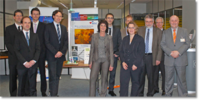 The project was funded at Technische Univerversität Kaiserslautern and Johannes Gutenberg-Universität Mainz together with Sensitec, a company sprecializing on sensors, and aimed to exploit innovative magnetic microsystems for usage in fields as automation, bioanalysis and safety technology, thereby bridging the gap between fundamental research and industrial application. ...
The project was funded at Technische Univerversität Kaiserslautern and Johannes Gutenberg-Universität Mainz together with Sensitec, a company sprecializing on sensors, and aimed to exploit innovative magnetic microsystems for usage in fields as automation, bioanalysis and safety technology, thereby bridging the gap between fundamental research and industrial application. ...03.02.2015
Physicists observe motion of tiny magnetic whirls - Skyrmions are candidates for future data storage and information processing
Small magnetic whirls may revolutionize future data storage and information processing if they can be moved rapidly and reliably in small structures. A team of scientists of Johannes Gutenberg University Mainz (JGU) and TU Berlin, together with colleagues from the Netherlands and Switzerland, has now been able to investigate the dynamics of these whirls experimentally. The skyrmions, as these tiny whirls are called after the British nuclear physicist Tony Skyrme, follow a complex trajectory and even continue to move after the external excitation is switched off. This effect will be especially important when one wants to move a skyrmion to a selected position as necessary in a future memory device. This research was published in the journal Nature Physics with a student of the Graduate School of Excellence Materials Science in Mainz (MAINZ) as the first author.
Skyrmions are small whirls in the magnetization of magnetic materials. In the case of the present work, the skyrmions have a diameter of less than 100 nanometers. This corresponds roughly to a thousandth of a hair width. To prepare these skyrmions, scientists at Mainz University prepared small magnetic discs. "When we apply a specific external magnetic field, the magnetization in these discs creates whirls," said Dr. Benjamin Krüger working in the group of Professor Mathias Kläui at the Institute of Physics at JGU. These skyrmions were then excited by a magnetic field pulse to trace their motion.
The scientists were now able to experimentally investigate the dynamics of these structures on short time scales for the first time. For these investigations, a holographic measurement setup using short and highly energetic X-ray pulses was used. This technique, which was developed at TU Berlin, can take images with a temporal separation of less than a nanosecond. The position of the whirl can be determined from these images to be compared with theoretical calculations.
"The measurements show that the skyrmions move on a very complex trajectory, a so- called hypo-cycloid," says Krüger. The fact that the skyrmions move on such a curved trajectory means that they must possess some inertia. This is comparable to a car that continues to move, even though the gas pedal is no longer pressed. The inertia of the skyrmion stems from the fact that the whirl can deform. In this way it is able to store energy; after the excitation has stopped, this energy leads to a continuation of the motion.
"This effect has not been taken into account up to now, but it is important for the development of small magnetic memories," explained Professor Mathias Kläui. "This effect has to be taken into account to enable the distinct positioning of the skyrmion in the memory." Skyrmions may be important for the future of magnetic data storage and information processing. These whirls can be moved rapidly and reliably along nanowires or other structures in future memories. Such a memory would retain its information even when the power is switched off. In addition, it would not need to contain any moving parts, such as a read and write head in a hard disk drive.
A comparison with computer simulations at Mainz University showed that the type of motion depends a little on the shape of the disk in which the whirl is formed. In addition, there is only a small dependence on defects in the material. There is, however, a substantial dependence on the shape of the whirl, its so-called topology. This implies that the present findings can be extended to all skyrmions with the same topology.
"I am happy about the good collaboration with our colleagues and about the fact that the experimental measurements, as well as the theory, were done by members of the JGU Institute of Physics and the MAINZ Graduate School of Excellence together," Kläui added. Funding of the Graduate School Materials Science in Mainz was approved in the Excellence Initiative of the German federal and state governments in 2007 and was prolonged by an additional five years in the second round of the initiative in June 2012. MAINZ combines work groups from Johannes Gutenberg University Mainz (JGU), the University of Kaiserslautern, and the Max Planck Institute for Polymer Research in Mainz. One of its research focuses is spintronics, a field in which collaborations with international partners play an important role. ...
28.01.2015
2 MAINZ members selected for ERC Awards 2014!
MAINZ lecturer Martin Weides has been selected for an ERC Consolidator Grant with a project on interfacing spin waves with superconducting quantum circuits. MAINZ director Mathias Kläui has been selected for a Proof of Concept Grant on magnetic sensing.
ERC Proof of Concept Grant 2014- all funded Projects
ERC Consolidator Grants 2014 results
Dr. Michael Fuchs new MAINZ General Manager
On January 2nd Dr. Michael Fuchs took over the position as MAINZ general manager. Prior to this, he worked for the DFG head office. He follows Dr. Mark Bajohrs who has taken over position as head of dean's office in the JGU’s faculty of biology. ...
04.12.2014
Mathias Kläui has been appointed Fellow of the Institute of Physics (IOP) due to his achievements in the field of physics and his contributions in nanomagnetism and spin dynamics
 The IOP is the British and Irish physical society with worldwide more than 50.000 members. The fellows of the IOP are characterized by their high level of achievements in physics and their outstanding contributions to the profession. ...
The IOP is the British and Irish physical society with worldwide more than 50.000 members. The fellows of the IOP are characterized by their high level of achievements in physics and their outstanding contributions to the profession. ...26.11.2014
MAINZ PhD Christoph Kreitner (group of Prof. Heinze) publishes a cover article in the European Journal of Inorganic Chemistry 2014
 The publication “Redox and Photochemistry of Bisterpyridineruthenium(II) Amino Acids and Their Amide Conjugates – from Understanding to Applications”, published in the European Journal of Inorganic Chemistry 2014 (http://onlinelibrary.wiley.com/doi/10.1002/ejic.201402466/abstract), summarizes the research conducted in the group of Prof. Katja Heinze in the field of ruthenium complexes with tridentate polypyridine ligands in the past 10 years. By integrating amino and carboxylic acid functionalities in the ligand backbone of these polypyridineruthenium complexes it was possible to generate artificial amino acids with unique properties: these are strongly colored dyes absorbing green light (in the range of 450-550 nm) and are red-light emitters at room temperature. First work on this class of complexes was devoted to the profound understanding of their redox and optical properties, especially the origin of the intense color and the observed emission. Additionally, electron and energy transfer between these amino acids and different donor and acceptor molecules were studied in order to develop a clearer picture of the reaction mechanisms involved on a molecular level. The insight gained from these original studies enabled further research towards potential applications for these complexes. Apart from nanoscale hybrid structures bis(terpyridine)ruthenium(II) amino acid and its derivatives have recently found application in dye-sensitized solar cells and light-emitting electrochemical cells. The review “Redox and Photochemistry of Bis(terpyridine)ruthenium(II) Amino Acids and Their Amide Conjugates – from Understanding to Applications” was written by two doctoral candidates, Christoph Kreitner and Aaron Breivogel, under supervision of Prof. Katja Heinze. Christoph Kreitner is financially supported during his doctoral thesis by the Graduate School Materials Science in Mainz while Aaron Breivogel is member of the International Training and Research Group 1404. The article was highlighted as cover article in the latest issue of European Journal of Inorganic Chemistry (http://onlinelibrary.wiley.com/doi/10.1002/ejic.201490156/abstract, cover profile: http://onlinelibrary.wiley.com/doi/10.1002/ejic.201402991/abstract). ...
The publication “Redox and Photochemistry of Bisterpyridineruthenium(II) Amino Acids and Their Amide Conjugates – from Understanding to Applications”, published in the European Journal of Inorganic Chemistry 2014 (http://onlinelibrary.wiley.com/doi/10.1002/ejic.201402466/abstract), summarizes the research conducted in the group of Prof. Katja Heinze in the field of ruthenium complexes with tridentate polypyridine ligands in the past 10 years. By integrating amino and carboxylic acid functionalities in the ligand backbone of these polypyridineruthenium complexes it was possible to generate artificial amino acids with unique properties: these are strongly colored dyes absorbing green light (in the range of 450-550 nm) and are red-light emitters at room temperature. First work on this class of complexes was devoted to the profound understanding of their redox and optical properties, especially the origin of the intense color and the observed emission. Additionally, electron and energy transfer between these amino acids and different donor and acceptor molecules were studied in order to develop a clearer picture of the reaction mechanisms involved on a molecular level. The insight gained from these original studies enabled further research towards potential applications for these complexes. Apart from nanoscale hybrid structures bis(terpyridine)ruthenium(II) amino acid and its derivatives have recently found application in dye-sensitized solar cells and light-emitting electrochemical cells. The review “Redox and Photochemistry of Bis(terpyridine)ruthenium(II) Amino Acids and Their Amide Conjugates – from Understanding to Applications” was written by two doctoral candidates, Christoph Kreitner and Aaron Breivogel, under supervision of Prof. Katja Heinze. Christoph Kreitner is financially supported during his doctoral thesis by the Graduate School Materials Science in Mainz while Aaron Breivogel is member of the International Training and Research Group 1404. The article was highlighted as cover article in the latest issue of European Journal of Inorganic Chemistry (http://onlinelibrary.wiley.com/doi/10.1002/ejic.201490156/abstract, cover profile: http://onlinelibrary.wiley.com/doi/10.1002/ejic.201402991/abstract). ...17.11.2014
Interregional Research Award 2014 for the group of Prof. Katja Heinze (Institute of Inorganic Chemistry and Analytical Chemistry)
Together with their cooperation partner Centre de Recherche Public – Gabriel Lippmann (Luxembourg) the group of Prof. Katja Heinze is awarded the Interregional Research Award 2014 (first prize, 35.000 €). In this multinational cooperation project (SURFAMINE) – funded by the Fonds National de la Recherche – novel intelligent foils for food packaging have been developed.
Within the SURFAMINE project the teams have designed, synthesized and employed novel pigments for incorporation into a plasma-deposited layer suitable for food packaging. These intelligent foils detect spoiled food via a colorimetric signal of the embedded pigment upon its interaction with volatile amines formed by bacterial decomposition of amino acids. ...
07.11.2014
Topological states of matter can be grown like crystals
Topological order, emerging as a collective behavior of a physical system, is an intriguing concept which attracted growing interest in many fields of physics during the last years. It allows to classify phases of matter that are not characterized by symmetries alone. Beyond the fundamental interest in such phases, they have intriguing applications in quantum computation and may be of significant practical relevance.
Recently it has been argued that ultra cold quantum gases as well as photonic systems can be promising platforms to investigate topological order in a way that is inaccessible in the solid-state. While the required Hamiltonians are essentially available in the laboratory today, a major challenge is to find a reliable scheme for the preparation of the corresponding ground states especially in interacting systems. In particular, most of previous works suggested adiabatic approaches that rely on finite-size energy gaps, and therefore, are doomed to fail for larger system sizes. A team of researchers from the group of M. Fleischhauer at the University of Kaiserslautern lead by MAINZ student Fabian Grusdt has now developed a new approach for growing quantum states with topological order, which overcomes these problems. In an international collaboration with M. Hafezi from the Joint Quantum Institute / NIST in the Washington D.C. area they proposed and analyzed a scheme that works much like conventional crystal growth. They show that starting from a small number of particles, half-filling Laughlin states of bosons can be grown by adding particles along with magnetic flux quanta one-by-one. This is achieved by combining a simple coherent pump with an interaction-blockade and a topologically protected, so called Thouless pump. The scheme can be applied to experiments in circuit quantum electrodynamics with current technology, and paves the way towards preparing more complicated topologically ordered states with exotic properties such as non-Abelian braiding statistics.
The work has been published recently in the prestigious journal Physical Review Letters:
F. Grusdt, F. Letscher, M. Hafezi, M. Fleischhauer, Physical Review Letters 113, 155301 (2014). ...
06.10.2014
MAINZ Visiting Professorship 2014 awarded to Prof. Stephan Link (on the right) and Prof. Andrei Slavin (on the left)!
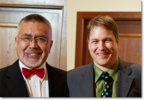 The MAINZ Visiting Professorship allows these researchers to perform part of their research at MAINZ and to interact with the PhD students of the graduate school. The awardees can stay at MAINZ for up to 12 months during a three-year period. ...
The MAINZ Visiting Professorship allows these researchers to perform part of their research at MAINZ and to interact with the PhD students of the graduate school. The awardees can stay at MAINZ for up to 12 months during a three-year period. ...06.10.2014
MAINZ Award 2013 awarded to Dr. Leonie Mück and Dr. Christoph Schüll!
 Leonie Mück on the right received the award for her work on highly accurate quantum chemistry. Christoph Schüll was recognized for his dissertation in the field of Multifunctional Macromolecular Architectures Based on Hyperbranched Polyglycerol. ...
Leonie Mück on the right received the award for her work on highly accurate quantum chemistry. Christoph Schüll was recognized for his dissertation in the field of Multifunctional Macromolecular Architectures Based on Hyperbranched Polyglycerol. ...02.10.2014
MAINZ Director Mathias Kläui interviewed for "Welt der Physik" podcast
 The podcast of "Welt der Physik" presents every 14 days a selection of the most exciting projects of research in physics. In episode 170 MAINZ Director Mathias Kläui explains possible applications of spintronics. ...
The podcast of "Welt der Physik" presents every 14 days a selection of the most exciting projects of research in physics. In episode 170 MAINZ Director Mathias Kläui explains possible applications of spintronics. ...24.09.2014
MAINZ Associated Member Román Orús was awarded the Early Career Prize of the European Physical Society
 The EPS Early Career Prize has been created to recognize contributions from young physicists to European research. Román Orús has been awarded the prize for his contributions to the development and reputation of European expertise in tensor networks. ...
The EPS Early Career Prize has been created to recognize contributions from young physicists to European research. Román Orús has been awarded the prize for his contributions to the development and reputation of European expertise in tensor networks. ...29.09.2014
JACS Publication on One-Pot Synthesis and AFM Imaging of a Triangular Aramide Macrocycle with participation of the former MAINZ Member Christoph Hauke
Abstract:
Macrocyclizations in exceptionally good yields were observed during the self-condensation of N-benzylated phenyl p-aminobenzoates in the presence of LiHMDS to yield three-membered cyclic aramides that adopt a triangular shape. An ortho-alkyloxy side chain on the N-benzyl protecting group is necessary for the macrocyclization to occur. Linear polymers are formed exclusively in the absence of this Li-chelating group. A model that explains the lack of formation of other cyclic congeners and the demand for an N-(o-alkoxybenzyl) protecting group is provided on the basis of DFT calculations. High-resolution AFM imaging of the prepared molecular triangles on a calcite(10.4) surface shows individual molecules arranged in groups of four due to strong surface templating effects and hydrogen bonding between the molecular triangles.
Journal of the American Chemical Society 136(37), 12832-12835 (2014)
C. Storz, M. Badoux, C.M. Hauke, T. Šolomek, A. Kühnle, T. Bally, A.F.M. Kilbinger
doi: 10.1021/ja506646s ...
25.07.2014
Mathias Kläui elected as director of the Gutenberg Nachwuchskolleg
 The Gutenberg Nachwuchskolleg ist one of the three Colleges of Excellence formed as part of the advanced institutional development of Johannes Gutenberg University. Its task is to advise the university leadership on matters of young scientists and fund measures to support this group of researchers with up to 1 Mio. € per year).
The Gutenberg Nachwuchskolleg ist one of the three Colleges of Excellence formed as part of the advanced institutional development of Johannes Gutenberg University. Its task is to advise the university leadership on matters of young scientists and fund measures to support this group of researchers with up to 1 Mio. € per year).As director of the Graduate School of Excellence Materials Science in Mainz, Mathias Kläui has broad experience in supporting PhD students. This know-how in addition to his previous experience in support organizations for postdoctoral fellows and academies of sciences for young scientists will be used to develop support measures tailored to young scientists at Johannes Gutenberg University Mainz. For more information (in German) please click on the link below. ...
23.07.2014
Gutenberg Nachwuchskolleg der Johannes Gutenberg-Universität Mainz nimmt Arbeit auf
JGU investiert jährlich 1.000.000 Euro in die nachhaltige Verbesserung der Arbeits- und Betreuungsbedingungen des wissenschaftlichen Nachwuchses
Mit der Einrichtung des Gutenberg Nachwuchskollegs (GNK) eröffnet die Johannes Guten-berg-Universität Mainz einen innovativen Weg zur Förderung des wissenschaftlichen Nach-wuchses. „Als Expertengremium im Rahmen der Exzellenzinitiative des Bundes und der Länder konzipiert, dient das Kolleg der Strukturierung und Kommunikation bestehender sowie der Entwicklung neuer Förderformate“, erklärt der Präsident der Johannes Gutenberg-Universität Mainz, Univ.-Prof. Dr. Georg Krausch, anlässlich der konstituierenden Sitzung. „Das GNK zielt dabei insbesondere auf die nachhaltige Verbesserung der Arbeits- und Betreuungsbedingungen des wissenschaftlichen Nachwuchses und der Bereitstellung individueller Unterstützungsangebote in den Karrierephasen zwischen Promotion und Festanstellung als Universitätsprofessorin bzw. -professor.“ ...
17.07.2014
MAINZ Faculty Member Michael Fleischhauer appointed to the Academy of Sciences and Literature in Mainz
The Academy of Sciences and Literature in Mainz has appointed Prof. Dr. Michael Fleischhauer from the Department of Physics at the University of Kaiserslautern as a new full member.
Professor Fleischhauer studied Physics at the Friedrich-Schiller Universität Jena and also obtained his PhD for research about non-classical properties of light there in 1991. After several research stays in the U.S., in New Mexico, in Texas and at Harvard University, he achieved his habilitation at the Ludwig-Maximilians-Universität München in 2000. In the same year he was appointed by the University of Kaiserslautern as Professor for Theoretical Physics. In his research Michael Fleischhauer developed, among others, an important procedure for the storage of quantum states. The method known as “Stopped Light” is a crucial feature for a photon-based quantum communication system. The internationally renowned theoretical Physicist is MAINZ Faculty and member of the State Research Center Optics and Material Sciences (OPTIMAS) of the University of Kaiserslautern. Next to research and teaching at the University of Kaiserslautern, the 51 year old physicist is also member of the editorial board of the renowned scientific journal Physical Review Letters. From 2008 to 2010 he headed the section “Quantum Optics and Photonics” of the Deutsche Physikalische Gesellschaft (German Physical Society, DPG), since 2012 he is member of the steering board of this world’s largest physical society. ...
20.06.2014
Active particles may enhance phase separation
 An international team – including Benjamin Trefz and Dr. Peter Virnau from MAINZ – showed that the addition of active particles may not only enhance phase separation, but can also be described in terms of an effective equilibrium theory. ...
An international team – including Benjamin Trefz and Dr. Peter Virnau from MAINZ – showed that the addition of active particles may not only enhance phase separation, but can also be described in terms of an effective equilibrium theory. ...30.05.2014
MAINZ at the Fourth International Conference for Young Scientists - Natural Resources in a Finite World
Mathias Kläui was invited to the meeting to discuss the impact of limited Natural Resources and the transformation to a sustainable world in particular with the respect to Materials Science and Engineering. The meeting gathers young scientists from around the world to discuss societal challenges and is organized by the Global Young Academy and supported by the International Council for Science together with further partners.
Picture: M. Kläui with B. Wrobel and H. Alper (right), Materials Chemist, Chair of Science, Technology and Innovation Council and previous Co-Chair of the InterAcademy Panel the Association of all Academies of Sciences.
12.05.2014
MAINZ Faculty members Jairo Sinova and Stuart Parkin receive Humboldt Professorships!
The Humboldt Foundation has granted two Humboldt Professorships to MAINZ Faculty members Sinova and Parkin. Sinova will use the award money to create a new center called SPICE at JGU. Congratulations to both faculty members!
30.04.2014
MAINZ PIs Waldvogel and Tremel acquire third-party funding through DFG-funded SPP!
The senate of the DFG has selected the SPP “Tailored Disorder” as one of 16 new priority programs. MAINZ PIs Waldvogel and Tremel will receive funding through the SPP. MAINZ congratulates its PIs on their success!
17.04.2014
Controlling the direction of photochemistry
MAINZ PhD student Robert Lindner, working in the group of Angelika Kühnle, reports on a novel strategy to steer on-surface reactions. Taking advantage of the lattice mismatch, well-oriented, covalently linked C60 domains are formed on an insulator.
10.04.2014
MAINZ External member Stuart Parkin picks up Millennium Prize 2014!
Stuart Parkin has been selected as the winner of the Millennium Prize 2014. Parkin has been an external member of MAINZ since 2010, is a fellow of the Gutenberg Research College and received the Gutenberg Research Award 2008 at JGU.
17.03.2014
New holographic process uses image-stabilized X-ray camera
The group of Prof. M. Kläui (JGU), including MAINZ PhD student Felix Büttner, developed in collaboration with Prof. S. Eisebitt (TU Berlin) a new X-ray holography method that will enable snap-shots of dynamic processes at highest spatial resolution.
26.02.2014
MAINZ Students join the JGU Gutenberg Academy
Christoph Kreitner (Heinze group), Stephan Köhler (Schmid group) and Daniel Rost (Binder group) were selected as new junior members of the Gutenberg Academy. The academy gives them the chance to participate in interdisciplinary exchange and to interact with outstanding researchers.
27.01.2014
MAINZ scholarship holders and alumni of the German National Academic Foundation meet mayor of the city of Mainz to discuss support for disadvantaged pupils
The projects "Chancengleichheit" and "Teach First Deutschland" support disadvantaged pupils by providing coaching and tutoring. Both activities were presented to Michael Ebling, Lord Mayor of Mainz, and Prof. Dr. Mathias Kläui, Director of MAINZ.
28.10.2013
MAINZ Alumni have met for the first time!
The first Alumni meeting of MAINZ has attracted fomer PhD students from all over Germany to come to Sörgenloch. Future meetings will take place annually on the last weekend in October.
21.10.2013
Humboldt Professorship awarded to Jairo Sinova for MAINZ professorship in theoretical physics at JGU!
On initiative of MAINZ a new professorship in theoretical physics will be established in electronic and magnetic properties of condensed matter. Jairo Sinova has now received a Humboldt Professorship worth 3.5 Mio € associated with this position.
15.10.2013
MAINZ Alumni awarded the MAINZ Award for their outstanding PhD theses within the Graduate School!
 Anna Maria Hofmann and Christine Tonhauser were selected as recipients of the highest distinction that MAINZ has to offer for its former PhD students. Hofmann currently works at Evonik and Tonhauser works at BASF. Congratulations! ...
Anna Maria Hofmann and Christine Tonhauser were selected as recipients of the highest distinction that MAINZ has to offer for its former PhD students. Hofmann currently works at Evonik and Tonhauser works at BASF. Congratulations! ...11.10.2013
MAINZ Visiting Professorship awarded to Prof. Zabel!
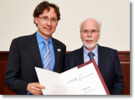 MAINZ has awarded the MAINZ Visiting Professorship to experimentalist Zabel from Ruhr University in Bochum. Zabel is covering topics in soft and hard condesed matter physics and will visit MAINZ regularly for teaching and research over the next 3 years. ...
MAINZ has awarded the MAINZ Visiting Professorship to experimentalist Zabel from Ruhr University in Bochum. Zabel is covering topics in soft and hard condesed matter physics and will visit MAINZ regularly for teaching and research over the next 3 years. ...01.10.2013
Report on MAINZ Student Seminar 2013 online!
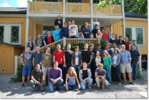 PhD Student Representatives Sebastian Golde and Markus Bannwarth report on this years student seminar in the swedish capital. The seminar is the main gathering of all MAINZ PhD students from all three institutions. It takes place every year in August. ...
PhD Student Representatives Sebastian Golde and Markus Bannwarth report on this years student seminar in the swedish capital. The seminar is the main gathering of all MAINZ PhD students from all three institutions. It takes place every year in August. ...18.09.2013
MAINZ student wins Poster Prize at IUPAC conference in Darmstadt!
14.09.2013
MAINZ PI and student publish paper on Domain walls as new information storage medium in Nature!
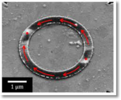 The research group of Prof. Kläui including MAINZ student Felix Büttner publishes findings in Nature Communications. ...
The research group of Prof. Kläui including MAINZ student Felix Büttner publishes findings in Nature Communications. ...21.08.2013
MAINZ Visiting Professorship 2013 awarded to experimentalist Prof. Hartmut Zabel and theorist Prof. David Landau!
12.08.2013
MAINZ Student Seminar 2014 takes place in Prague!
19.07.2013
Registration for MAINZ Technical Trainings opens!
 The specialized research training offered by MAINZ goes far beyond the scope of a single research group and includes interdisciplinary training and exchange of knowledge in different fields of materials science. Ranging from preparation and characterization to a combination of theory and experimental work, it provides PhD students with the expert knowledge needed for the application of modern experimental instrumentation as well as computer-assisted theoretical methods in the areas of materials development, data mining, quality control and safety issues. When finishing their PhD, our students have obtained broad and general knowledge in the areas of fundamental and application-oriented materials science, constituting the basis of products and devices to be used in and developed for advanced technologies where materials act as drivers of innovation. To reach these training goals, we have identified four cross-disciplinary Technical Training Areas. Technical Trainings in these areas are now open for registration.
The specialized research training offered by MAINZ goes far beyond the scope of a single research group and includes interdisciplinary training and exchange of knowledge in different fields of materials science. Ranging from preparation and characterization to a combination of theory and experimental work, it provides PhD students with the expert knowledge needed for the application of modern experimental instrumentation as well as computer-assisted theoretical methods in the areas of materials development, data mining, quality control and safety issues. When finishing their PhD, our students have obtained broad and general knowledge in the areas of fundamental and application-oriented materials science, constituting the basis of products and devices to be used in and developed for advanced technologies where materials act as drivers of innovation. To reach these training goals, we have identified four cross-disciplinary Technical Training Areas. Technical Trainings in these areas are now open for registration.15.07.2013
MAINZ Alumni Dr. Matthias Barz wins Emil and Paul Müller-Memorial-Foundation Award of JGU!
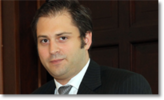 On the occasion of the DIES ACADEMICUS 2013 at JGU, MAINZ Alumnus Dr. Matthias Barz has been awarded for his PhD thesis "Functional polymer based nanoparticles: development of defined complex structures as basis for in vitro and in vivo applications" performed in the resaech group of MAINZ PI Prof. Dr. Zentel. ...
On the occasion of the DIES ACADEMICUS 2013 at JGU, MAINZ Alumnus Dr. Matthias Barz has been awarded for his PhD thesis "Functional polymer based nanoparticles: development of defined complex structures as basis for in vitro and in vivo applications" performed in the resaech group of MAINZ PI Prof. Dr. Zentel. ...15.07.2013
Group of MAINZ PI Carsten Sönnichsen presents novel multiplexed sensor!
 The group presents a novel multiplexed sensor with randomly deposited aptamer functionalized gold nanorods for efficient and cost-effective multiplexed detection schemes for proteins in small liquid samples would bring drastic advances to fields. ...
The group presents a novel multiplexed sensor with randomly deposited aptamer functionalized gold nanorods for efficient and cost-effective multiplexed detection schemes for proteins in small liquid samples would bring drastic advances to fields. ...15.07.2013
MAINZ PhD student Fabian Grusdt at Harvard University
MAINZ PhD student Fabian Grusdt from Kasierslautern is currently on a one-year stay at the Physics Department of Harvard University. Being a PhD student of Professor Michael Fleischhauer (TU KL), Fabian currently is doing research with the group of Professor Eugene Demler who was one of the first recipients of the Gutenberg Lecture Award of the Graduate School MAINZ. He is working at Harvard on the theory of the preparation as well as the detection of topological quantum states in quantum optical systems. In recent years topological states of matter have triggered an increasing amount of interest due to their implications for error tolerant quantum information protocols, which is related to their exotic elementary excitations in many body quantum systems. In the group of Professor Demler quantum optical model systems, like e.g. cold quantum gases, are being investigated with special emphasis on their potential for the realization and investigation of exotic topological quantum phases.
21.05.2013
First MAINZ Alumni Meeting to take place in autumn 2013!
02.05.2013
JGU Gutenberg Research College Fellow Stuart Parkin (IBM Research Almaden) to receive honorary doctorate from MAINZ partner!
10.04.2013
Thematic Network "SpinNet" with international partners of MAINZ kicks off!
The BMBF/DAAD-funded network will allow MAINZ PhD students to visit partners at IBM Research, Stanford University and Tohoku University. Additionally, partnerns will come to MAINZ for research and teaching. Joint summer workshops will also be organised.
05.04.2013
Mentoring Program of MAINZ gets its name and logo
The mentoring program of MAINZ, mentMAINZ, is managed by Edeltraud Eller and starts with 13 mentees in year 2013 who applied to the program. New applications will be possible later this year for 2014.
06.02.2013
MAINZ PI Jun.-Prof. Dr. Thomas Kühne publishes "Electronic signature of the instantaneous asymmetry in the first coordination shell of liquid water" in Nature Communications!
Mainz scientists confirm original tetrahedral model of the molecular structure of water
Researchers at Johannes Gutenberg University Mainz (JGU) have confirmed the original model of the molecular structure of water and have thus made it possible to resolve a long-standing scientific controversy about the structure of liquid water. "Our findings have important implications as they help reconcile the symmetric and asymmetric views on the structure of water," write the scientists in an article published in Nature Communications. The results may also be relevant to research into molecular and biological systems in aqueous solutions and provide insight into protein folding, for example. The work of Thomas Kühne's group was undertaken within an interdisciplinary joint project and was funded by the Research Unit Center for Computational Sciences at Johannes Gutenberg University Mainz.
30.01.2013
MAINZ PhD student Felix Büttner wins Best Poster Award at the 12th joint Magnetism and Magnetic Materials - Intermag Conference
Recent results of the first direct dynamic imaging of single Magnetic Skyrmion Bubble domains were presented by Felix Büttner in his poster "Time-resolved Imaging of the Gyrotropic Motion of Magnetic Bubbles" at the annual 2013 Joint MMM - Intermag conference, the largest magnetism meeting in the world. At this conference in Chicago, USA he received unanimous votes as the best poster amongst more than 100 poster contributions for the exciting demonstration of the gyrating motion of skyrmionic domain structures in confined geometries.
28.01.2013
MAINZ successful in attracting BMBF/DAAD funding for "Thematic Network"!
Funding for the proposed network SpinNet for 4-year period will be provided by the Federal Ministery of Education and Research through the German Academic Exchange Service. Apart from Johannes Gutenberg University, SpinNet includes partners from Stanford University, Tohoku University and IBM Research Almaden.
24.01.2013
New MAINZ Videos online at our youtube Channel!
Watch our videos on bio-related materials, model systems and correlated matter and spintornics. All of them are available at our youtube channel.
15.01.2013
Nomination for publication of the PhD thesis of MAINZ alumni Sebastian Will at Springer Verlag successful!
Springer Verlag has accepted the nomination of the PhD thesis of MAINZ alumni Sebastian Will by the MAINZ and the University of Munich as an outstanding contribution!
13.12.2012
External Member of MAINZ Stuart Parkin recognized for great service to interdisciplinary materials research
Experimental physicist Stuart Parkin of the IBM Almaden Research Center in San Jose, California and external member of MAINZ and the Gutenberg Research College received the von Hippel Award 2012.
10.10.2012
An international research team including MAINZ student Felix Büttner found at FLASH a surprising effect!
This effect could be the key to further miniaturization and performance increase of magnetic data storage devices. The results have been published in the current issue of "Nature Communications"
01.10.2012
MAINZ Award for Christina Birkel and Christian Ohm
Christina Birkel received the award for her work on new methods of synthesizing nanoparticles from antimony compounds. Christian Ohm was recognized for his dissertation in the field of organic chemistry.
03.07.2012
Gutenberg Lecture Award 2012 presented to Wolfgang Wernsdorfer from Institut Néel, CNRS (Grenoble)
Wernsdorfer received the award for his work on single molecular magnets, the magnetism of nanoparticles and for the development of the nano-SQUID.
15.06.2012
MAINZ is successful in attracting funding for a second period in the Excellence Initiative
13.06.2012
MAINZ student receives the Hugh Stott Taylor Award at Princeton University for the second time
12.06.2012
Gold nanoantennas detect proteins - New method of monitoring protein molecules using gold nanoparticles
Scientists at Johannes Gutenberg University Mainz (JGU) have developed a new method of observing individual proteins. Detailed knowledge of the dynamics of proteins is necessary in order to understand the related biological processes that occur on the molecular level. The method developed by the group of Mainz chemists led by Carsten Sönnichsen is based on the use of gold nanoparticles. These serve as glistening nanoantennas that, when they detect individual unlabeled proteins, slightly change their frequency or, in other words, their color. These tiny color changes can be observed using the technique developed in Mainz.
14.05.2012
JUnQ wins Special Award at "Deutscher Ideenpreis"
Tthe Journal of Unsolved Questions (JUnQ) is honoured at "Deutscher Ideenpreis" as a platform generating learning through publishing failure. The Special Award is given to JUnQ by a jury consisting of representatives from science, industry and politics.
11.05.2012
Latest Advanced Functional Materials cover by MAINZ PhD student
Michael Schwall has suceeded in his bid for the latest cover of Advanced Functional Materials. The cover shows phase separation of a Heusler compound resulting in flower-like structures on the microscale. Schwall is persuing a PhD in the Felser group.
15.06.2012 - 16.06.2012
MAINZ and Princeton University meet for second workshop
PhD students of MAINZ and Princeton University meet at JGU Mainz for second workshop for scientific exchange and to foster further collaboration between both institutions. Leslie Schoop, a MAINz PhD Student from Claudia Felsers group, is currently performing her thesis project in Bob Cavas lab at Princeton to receive a double degree from Mainz and Princeton University.
10.05.2012
MAINZ students organized most visited symposium ‘Spintronics on the way to modern storage technology” at DPG 2012 meeting in Berlin
A joint initiative of a jDPG and the magnetism division of the DPG has established a new format this year. A the format allows PhD students to organise a symposium at the DPG meeting for other students. This years symposium organised by several MAINZ students was a great success and being one of the most attended sessions during the 76th DPG Spring meeting in Berlin between March 25-30, 2012. The talks of world-known experts in the field of magnetism attracted a high proportion of both young scientists and senior researchers. The program was specifically tailored in a way that invited talks were stitched with contributed ones; so that the topic was covered from basics to modern applications.
The organising MAINZ PhD student team sincerely thanks Prof. M. Fiebig (ETH Zürich), Prof. H.-J. Elmers (JGU Mainz) and S. Köhler (JGU Mainz) for the organizational support and the Graduate School MAINZ for the financial support.
10.05.2012
MAINZ PhD student wins Best Poster Award at the Intermag 2012
Felix Büttner was honoured for his outstanding poster "New soft high anisotropy materials for magnetization dynamics of solitonic spin structures" at the 2012 International Magnetics Conference (Intermag) in Vancouver, Canada. Mr. Büttner is currently carrying out a PhD on magnetic soliton dynamics in the group of Mathias Kläui.
10.05.2012
MAINZ PhD student receives "Vodafone Förderpreis 2012"
The "Vodafone Förderpreis" worth 5000€ is awarded annually for diploma/master/PhD thesis for outstanding research in the field of mobile communications. Hubertus Braun was awarded "Vodafone Förderpreis" for his diploma thesis on the development and investigation of low loss dielectric glass-ceramic materials for the use as dielectrics in microwave electronics. He performed his diploma thesis under supervision of G. Jakob and in collaboration with SCHOTT (Martin Letz) as well as the Technical University of Darmstadt (Rolf Jakoby). Braun has joined MAINZ recently and is currently pursuing a PhD in the group of H.J. Elmers.
17.04.2012 - 18.04.2012
Micromagnetics Tutorial in MAINZ
Prof. U. Nowak and Dr. K. Lebecki from the University of Konstanz give a Tutorial for Micromagnetics for MAINZ students and interested PhD students from the Chemistry and Physics departments at JGU. In addition to a theoretical lecture, two hands-on session were given to allow students to carry out their own simulations quickly. Micromagnetics describes the dynamics of magnetization on the nanoscale using numerical simulations and bridges time and length scales from ab-initio calculations to macroscopic properties. Prof. Nowak and Prof. Kläui have a joined project where theoretical and experimental studies work hand in hand to investigate the influence of temperature on magnetization.
07.02.2012
MAINZ PhD students Olga Meshcheriakova, Sandra Perkert, Dima Kutnyakhov and Christian Mix were successful in their bid to organize a Symposium for the DPG (German Physical Society) Spring Meeting
The idea to solicit proposals for a symposium from PhD students for PhD students is a joint initiative of the Magnetism division and the young DPG. For this year's inaugural call more than 10 student consortia put forward suggestions for symposia from which the proposal of the MAINZ student consortium was selected. The symposium is a special session of the DPG Spring meeting in Berlin, March 25-30, 2012, which is the largest Physics meeting in Europe with 6000 participants.
[read more]31.01.2012
JUnQ finishes fourth in race for Hochschulperle 2011
For more informations about the contest, and all it's participants click here.
23.01.2012
Third issue of the Journal of Unsolved Questions (JUnQ) published by the Graduate School MAINZ is now available
The 3rd issue of the Journal of Unsolved Questions (JUnQ) is now available online and in print. JUnQ was founded in 2010 by doctoral students of the Graduate School of Excellence "Materials Science in Mainz" (MAINZ) in cooperation with scientists from around Europe. Since then, the journal has generated a great deal of interest. Its goal is to provide a forum through which information can be made available on the kind of excellent but inconclusive scientific projects that established scientific journals tend to ignore.
19.01.2012
JUnQ is up for election to become “University Pearl of the Year 2011"
Until January 23rd you can vote for the Journal of Unsolved Questions on www.hochschulperle.de.
For more information about the journal go to junq.info or listen to a radioconference with Leonie Mück, Thomas Jagau and Tobias Boll (in German).
01.12.2011
MAINZ strengthens network in China!
18.11.2011
Prof. Dr. Gerhard Wegner was awarded an honorary doctorate by the ETH Zurich
17.11.2011
MAINZ PI gave inauguration lecture at JGU!
16.11.2011
Robert J. Cava (Princeton University, Gutenberg Lecture Award 2011) receives Humboldt Fellowship for research visits at MAINZ/JGU and KIT!
Cava currently hosts one MAINZ PhD student in his laboratory at Princeton University who is aiming at a double degree from Princeton and from MAINZ/JGU. The Humboldt fellowship will allow Cava to spent time at MAINZ/JGU and at Karlsruhe Institute for Technolgy (KIT) to strenghten his ties with German researchers.
08.11.2011
MAINZ PhD student receives Hugh Stott Taylor Prize of Princeton University for outstanding academic performance.
17.10.2011
MAINZ PI receives ERC Advanced Grant worth 2,4 Mio Euro!
11.10.2011
JGU president Krausch honors Kookheon Char (Gutenberg Research Award 2006) at Seoul National University.
MAINZ and JGU intensify existent partnerships with top-class universities in Asia. Krausch honored Kookheon Char by presenting him with the certificate of appointment as a Fellow of the GRC and MAINZ.
28.09.2011
MAINZ PhD Student Leonie Mück wins Poster Prize at the Central European Symposium of Theoretical Chemistryin Poland
13.09.2011
MAINZ members observe different states of electrons in Heusler materials!
Scientists of JGU and MAINZ were able to observe the behavior of electrons in Heusler materials through usage of a novel lightsource of Japanese partners. This way they want to discriminate between the materials properties.
01.09.2011
JGU competes with other German universities in all three funding lines of the Excellence Initiative
Johannes Gutenberg University Mainz has submitted full proposals for a graduate school, three clusters of excellence, and its institutional strategy to promote top-level university research.
31.08.2011
JGU proven to be internationnaly outstanding in the field of physics
The Academic Ranking of World Universities has listed the Institute of Physics of Mainz University as one of the 75 best worldwide.
07.07.2011
Gutenberg Research Award 2011 of Graduate School MAINZ for Prof. Michael Graetzel
06.07.2011
MAINZ PI receives Nicholas Kurti Award 2011
28.06.2011
Support for optoelectronics in Mainz: Kookheon Char appointed as GRC fellow
Kookheon Char of the Korean elite institution Seoul National University has become a fellow of the GRC and will be mentoring doctoral students of the graduate school MAINZ.
30.06.2011
Victor Zhu from UC Berkeley visits MAINZ for an Internship
28.06.2011
MAINZ PhD student accepted at the Gutenberg Academy of Johannes Gutenberg University Mainz
The Gutenberg Academy is a program of JGU that supports young researchers and serves to foster interdisciplinary exchange. MAINZ PhD student Leonie Mück has just joint the academy and is now one of the two MAINZ members in the academy presently benefiting from the support offered. In total 22 PhD students of JGU are supported by the academy. ...
15.06.2011
MAINZ PhD student Nicolas Vogel wins poster prize at Nanoplasmonics Symposium in Spain
Nicolas Vogel wins one of the two Nanoscale Poster Prizes on “Coupling of Plasmon Modes in Nano-Crescent Dimer Structures Fabricated by Colloidal Lithography”.
The International Workshop on Nanoplasmonics for Energy and the Environment was held from 8-10 June 2011 in Sanxenxo, Spain.
28.05.2011
Open PhD positions in two collaborative projects with GRC-fellow Stuart Parkin from IBM Research Almaden (CA, USA)
The Graduate School MAINZ advertises two PhD positions with Stuart Parkin in collaborative supervision with PIs from MAINZ. Application closes on June 24, 2011 11:59 p.m. (GMT+1) via our online application interface. ...
02.05.2011
Stuart Parkin receives GRC-Fellowship of the JGU to strenghten cooperation with MAINZ
14.04.2011
Outstanding doctoral thesis of MAINZ students awarded the annual MAINZ Award
14.04.2011
Robert J. Cava receives Gutenberg Lecture Award 2011 of Graduate School MAINZ
01.04.2011
MAINZ PhD student project JUnQ awarded "Hochschulperle des Monats April" by Stifterverband der Wissenschaft!
"Hochschulperlen" are innovative projects which have been realised at a University. They are small but shiny. The Stifterverband awards this recognition monthly and pearls of one year have the chance to be named "pearl of the year". Keep your fingers crossed for our Journal of unsolved questions! Congratulations to the editors!
22.03.2011
Rhineland-Palatinate strengthens universities participating in the Excellence Initiative!
Prime Minister Beck and Minister of Science assure JGU and TU Kaiserslautern financial assistance in case of successful results! ...
17.03.2011
University of Mainz off to a flying start in the federal excellence competition!
Johannes Gutenberg University Mainz will hand-in prolongation proposal for the Graduate School Materials Science in Mainz (MAINZ), three proposals for excellence clusters (one related to our graduate school) and a future concept. Technical University Kaiserslautern will hand-in one proposal for an excellence cluster related to MAINZ. Proposals will be evaluated staring on September 1, 2011 by Deutsche Forschungsgemeinschaft and Wissenschaftsrat. Results are expected in summer 2012. ...
28.02.2011
Interview of MAINZ PhD student Thomas Jagau on JUnQ by Deutschlandfunk now online (in German)!
Interview with Thomas Jagau on publication of scientific results and on the current practice not to publish negative results. The Journal of unsolved questions (JUnQ) publishes negative results and open questions. The idea of JUnQ was born in a think tank of the Graduate School MAINZ and is a project of our PhD students. ...
17.02.2011
Doctoral students of "Materials Science in Mainz" publish first issue of Journal of Unsolved Questions
Our vision is establishing the publication of null-results as an important cornerstone for the advancement of knowledge and scientific understanding in all disciplines thus con- tributing to overcome biases and fraud in research. JUnQ is a new platform to gather ‘null’-result research. It is a medium to communicate projects, which just didn’t work, ambiguous data without exaggeration and unfinished investigations, which raise more questions than they answer. The idea of JunQ was born in a think tank of the Graduate School MAINZ and is a project of our PhD students. ...

